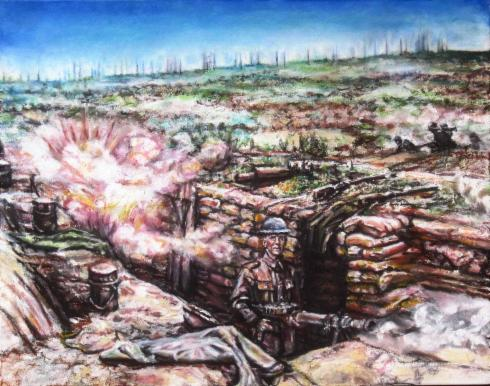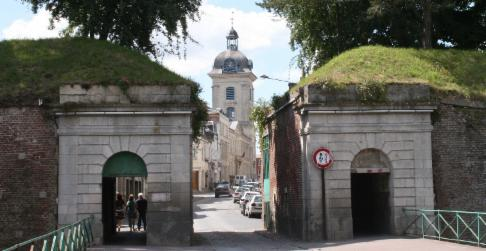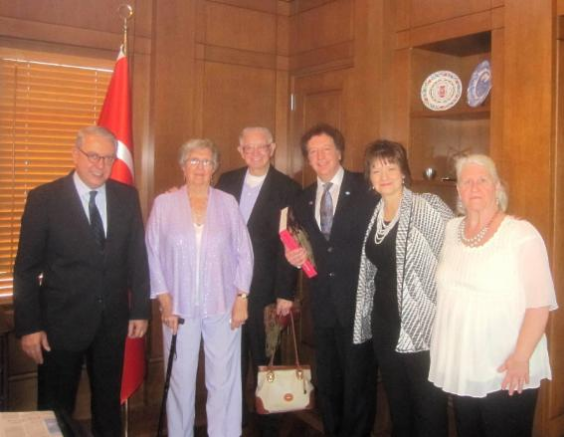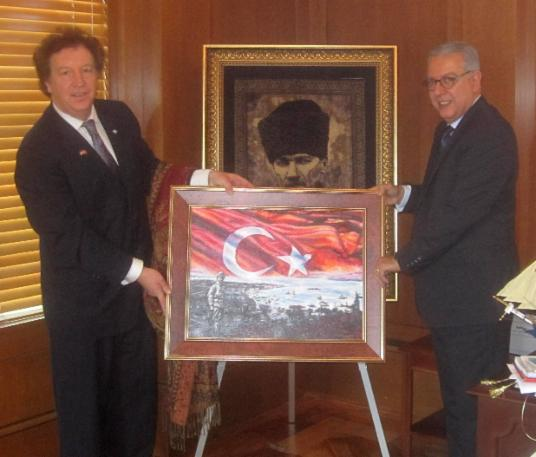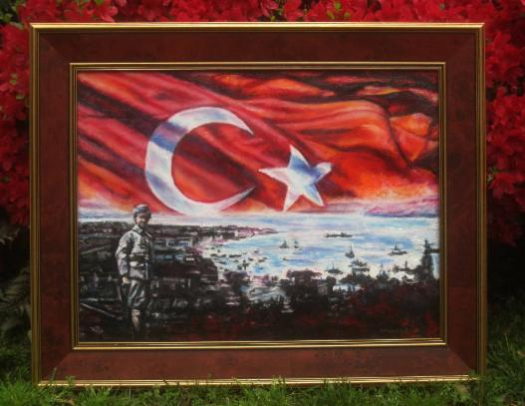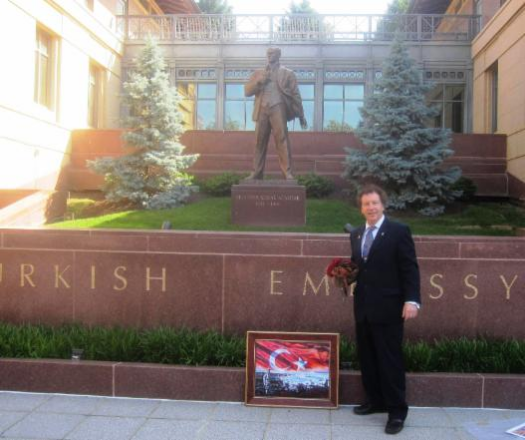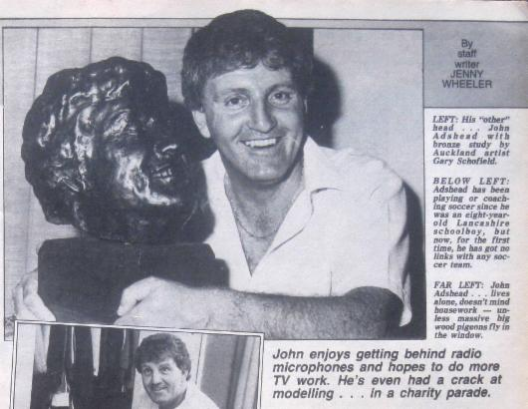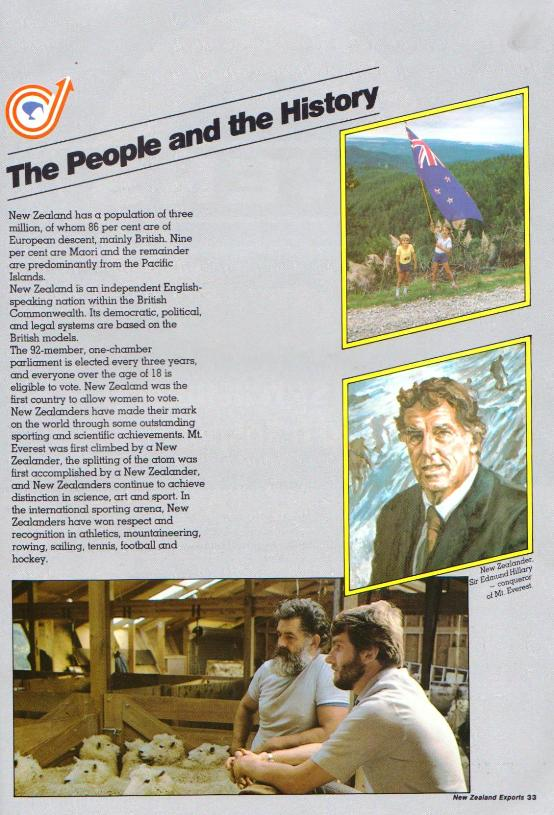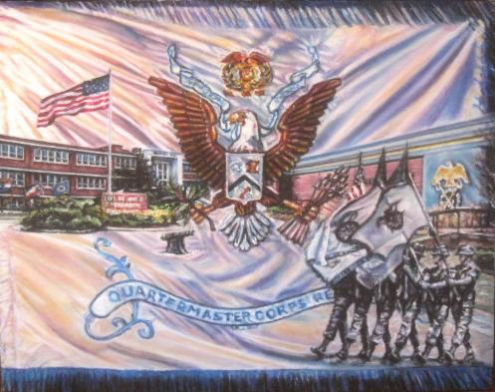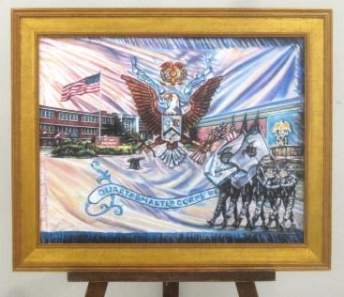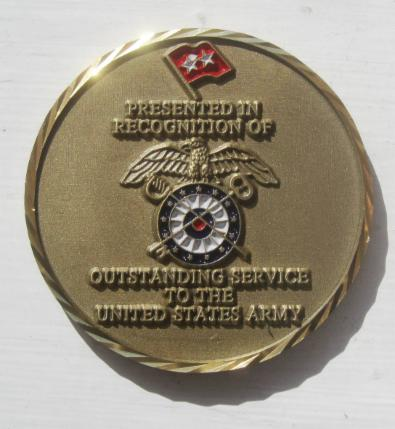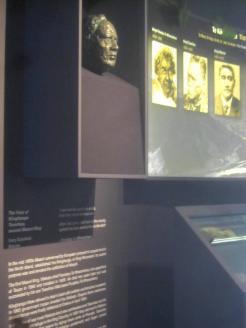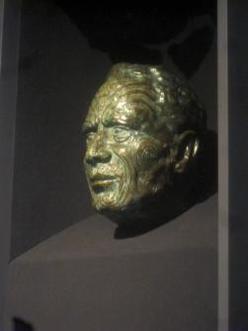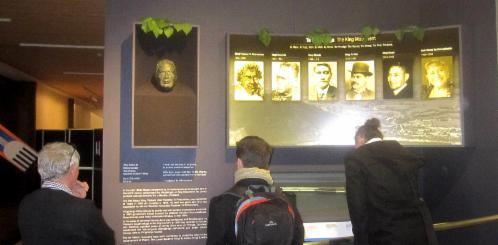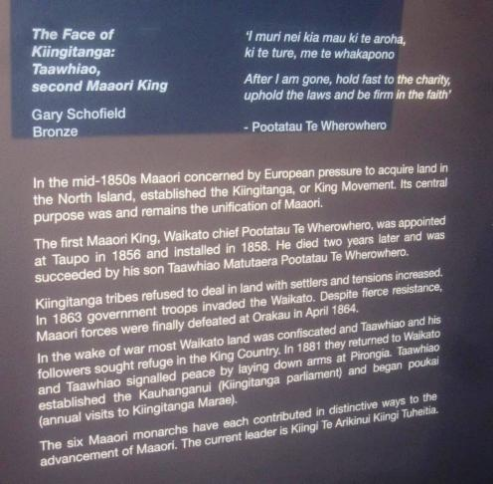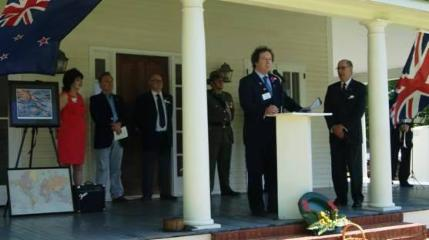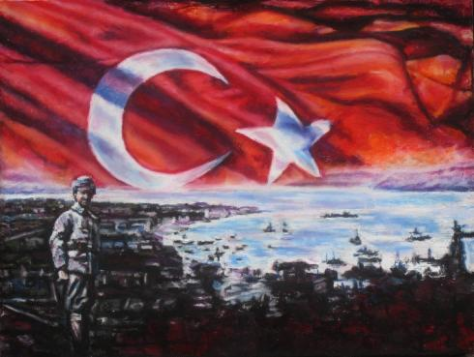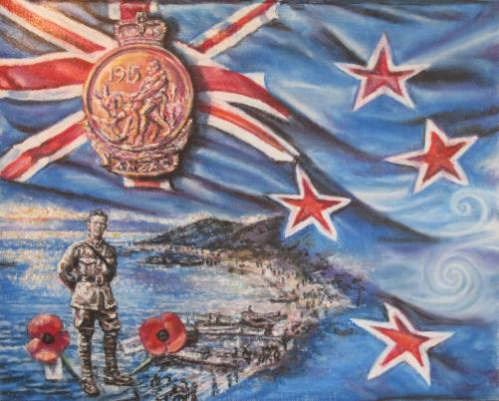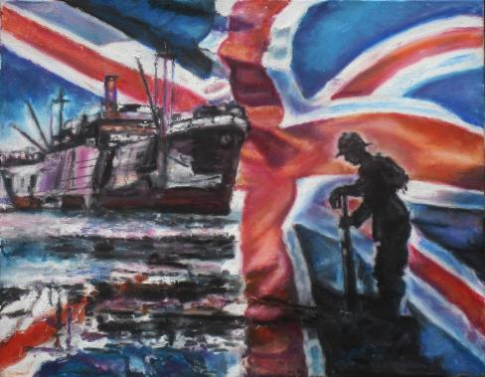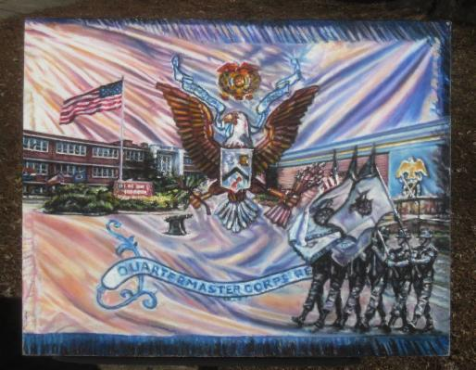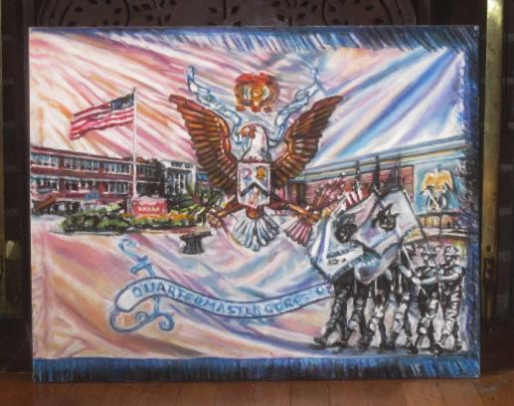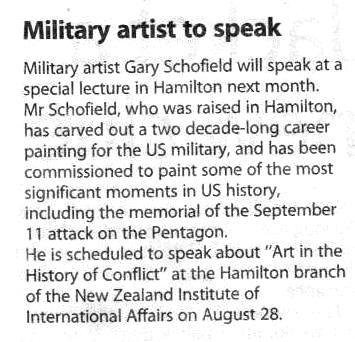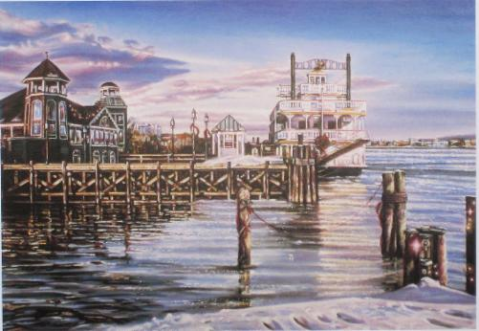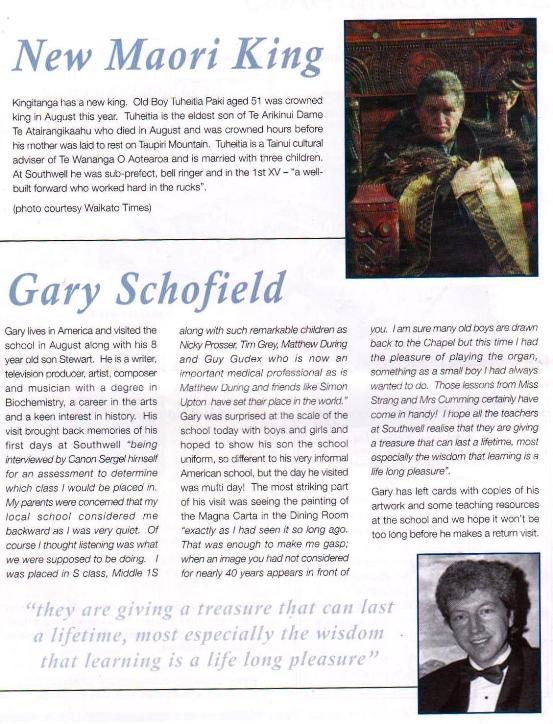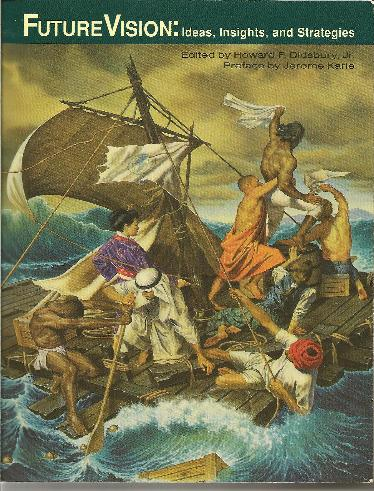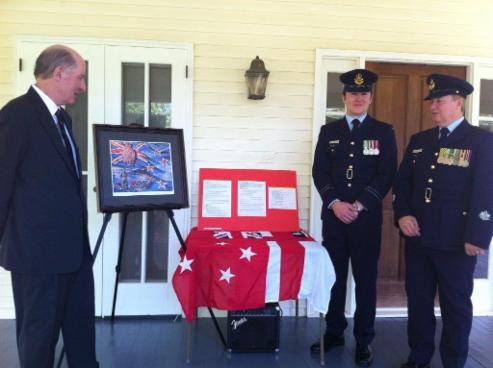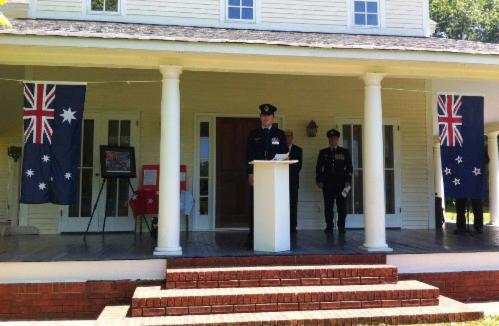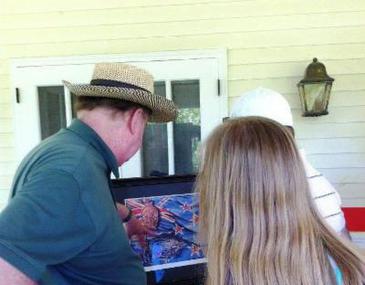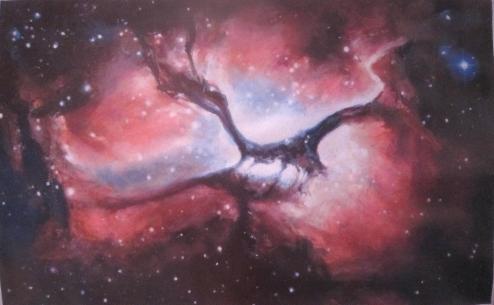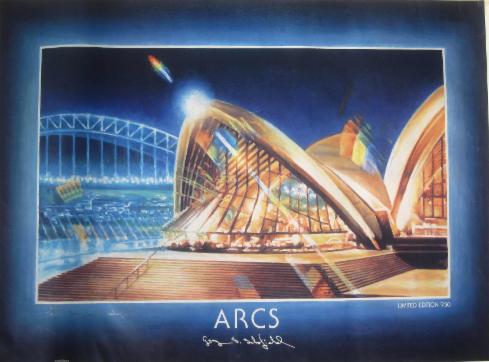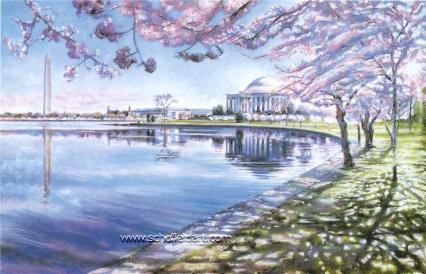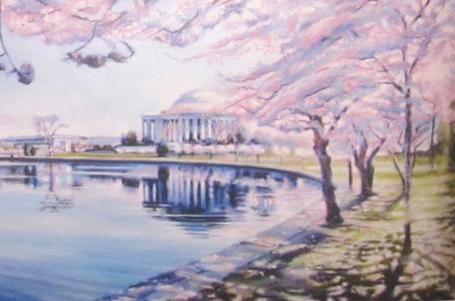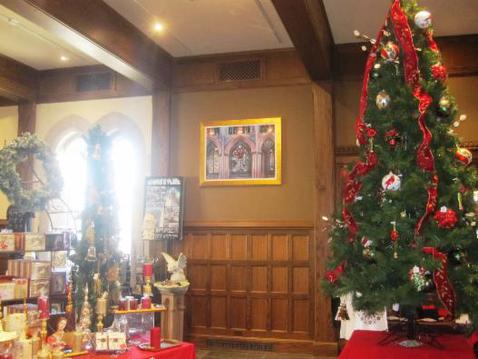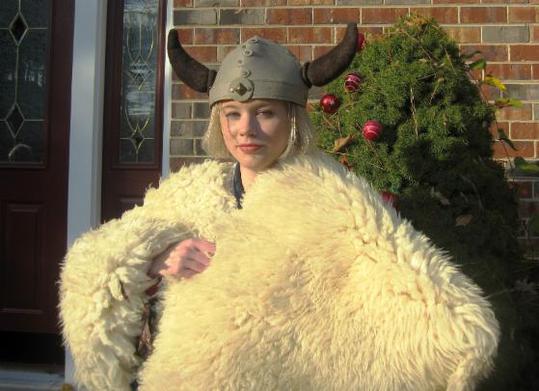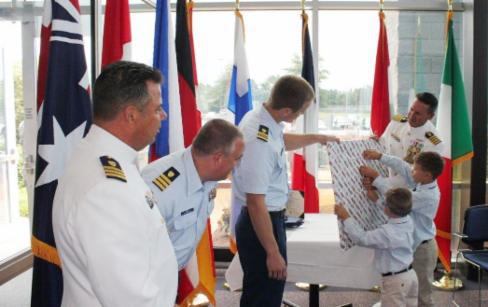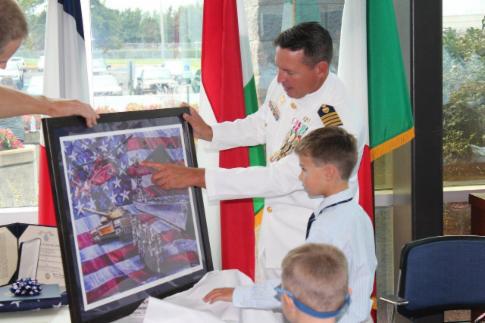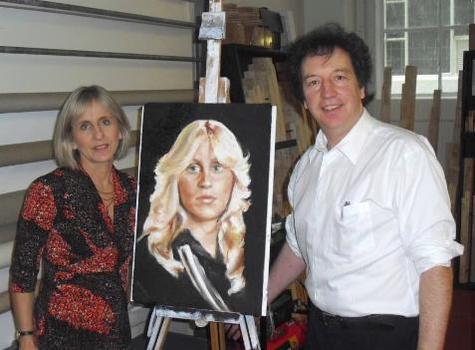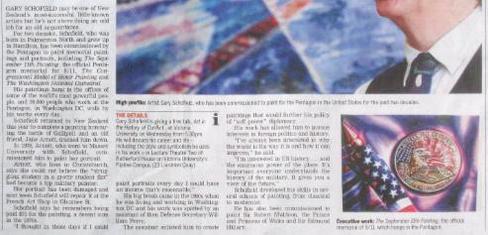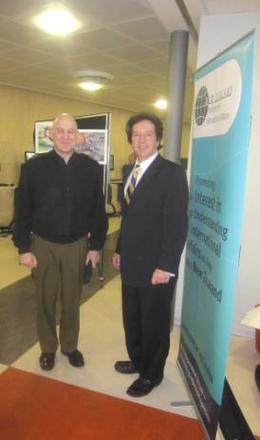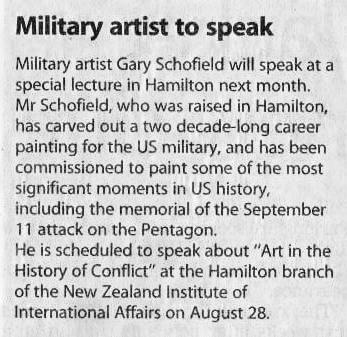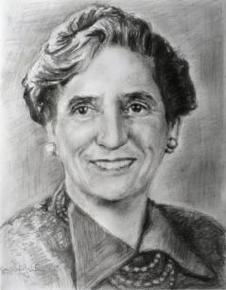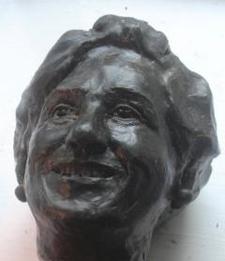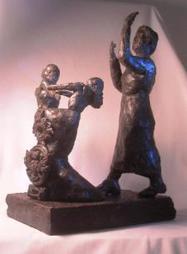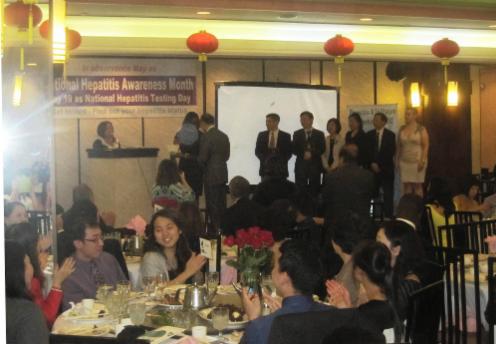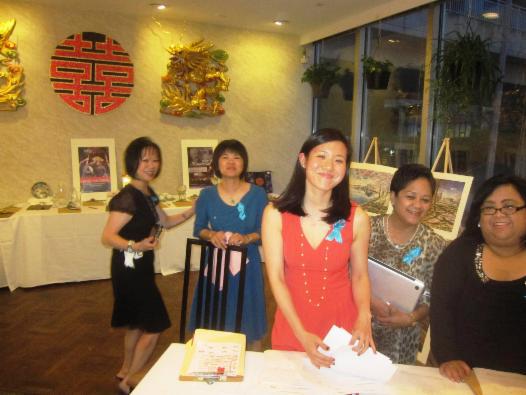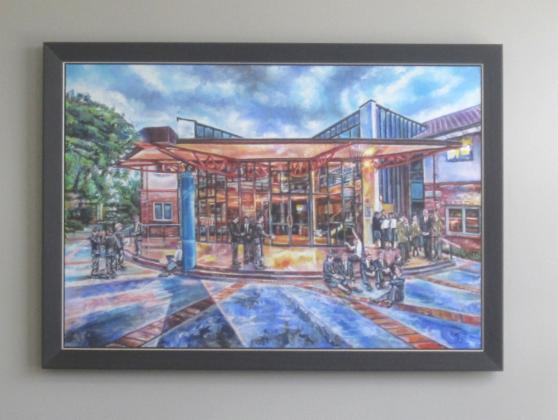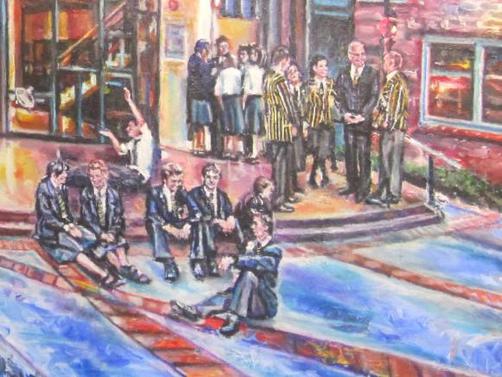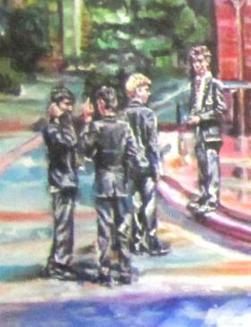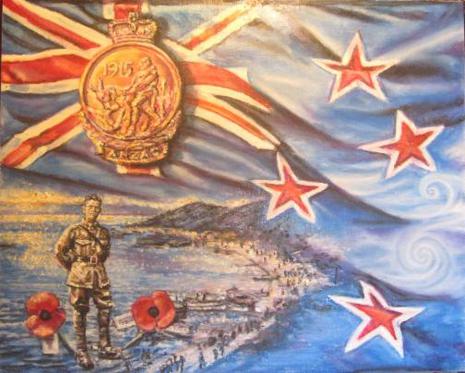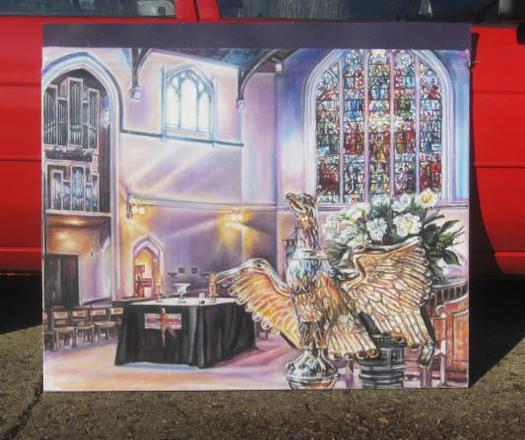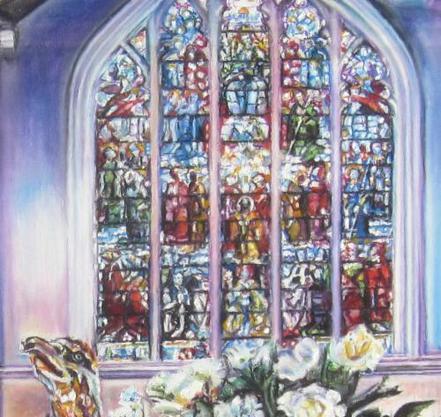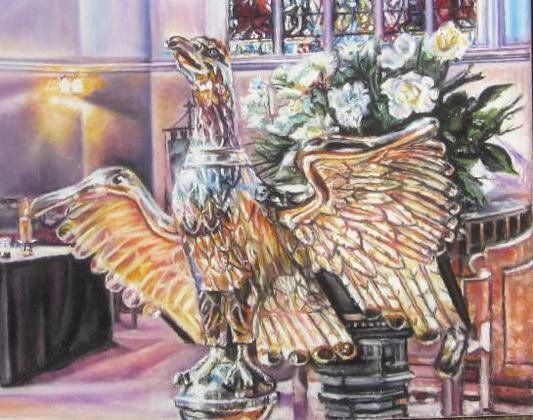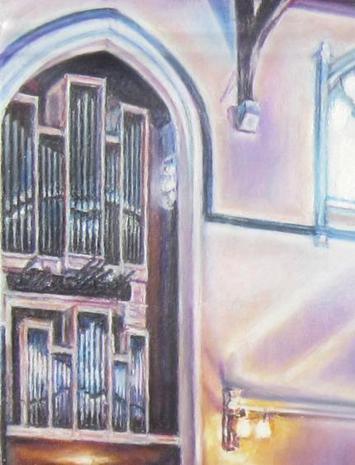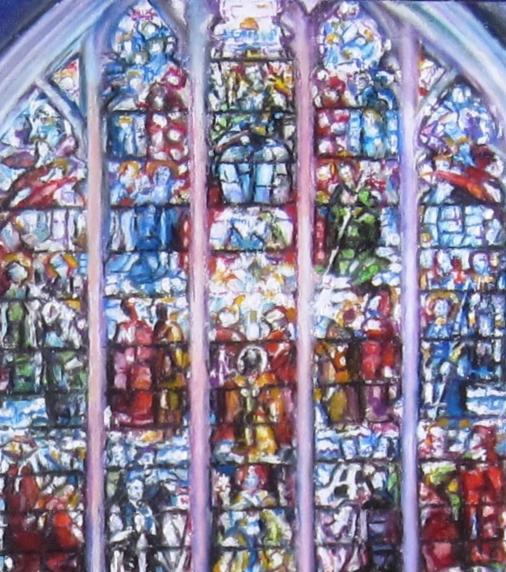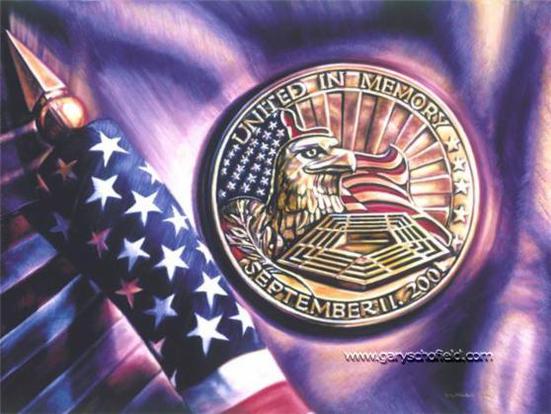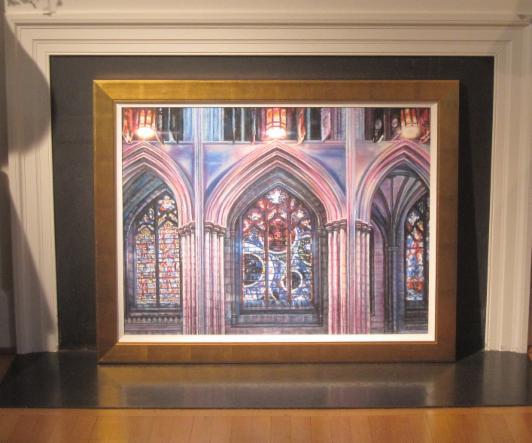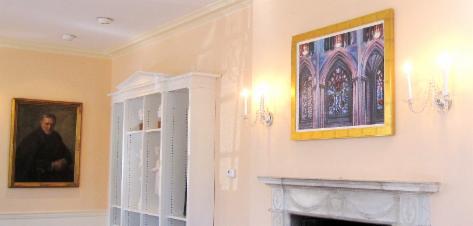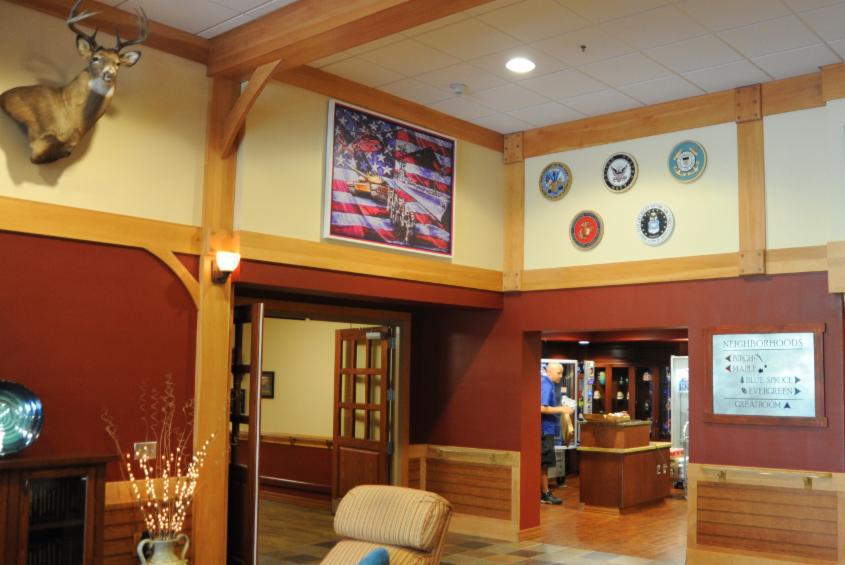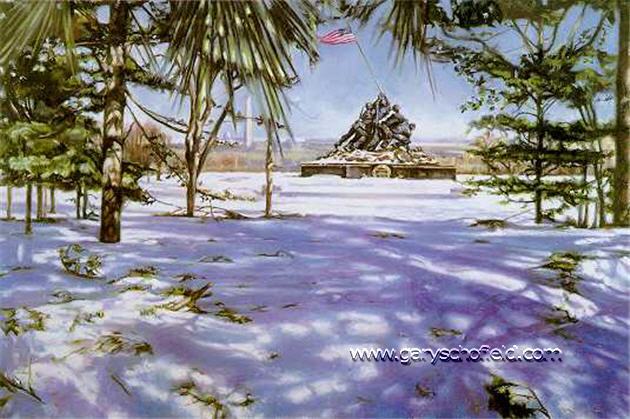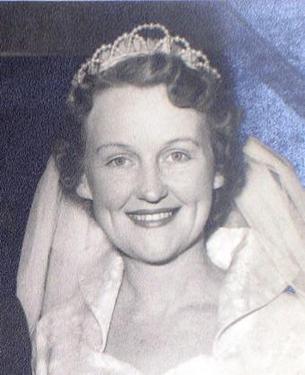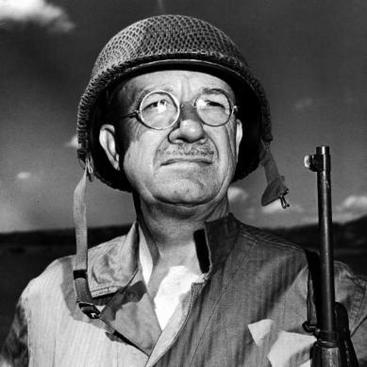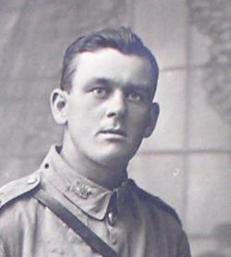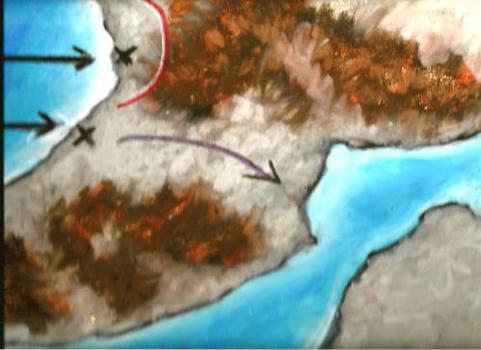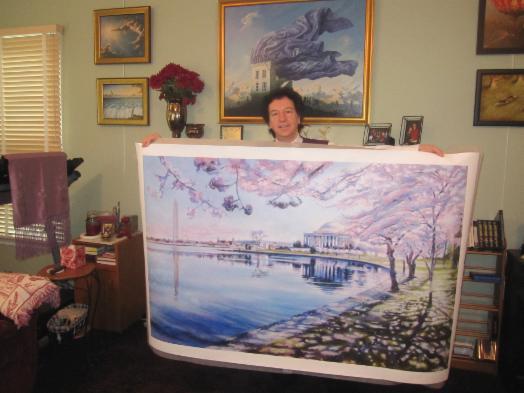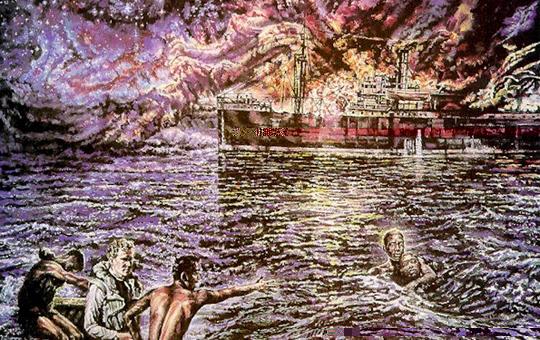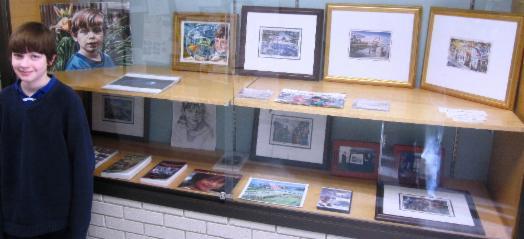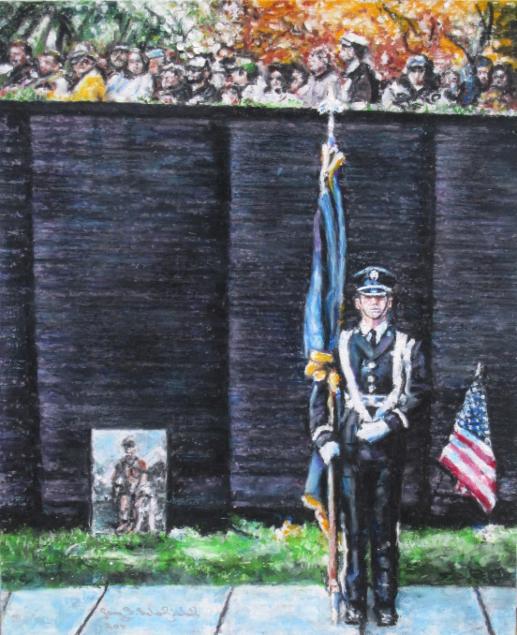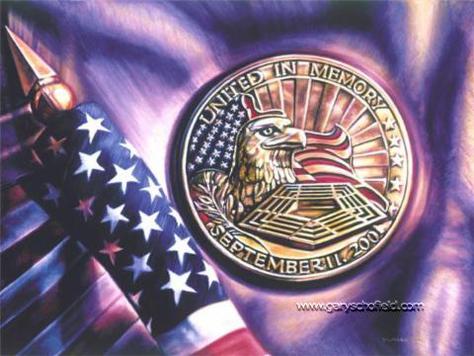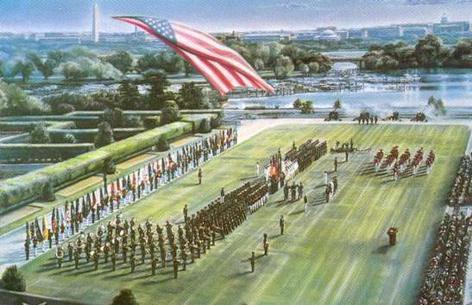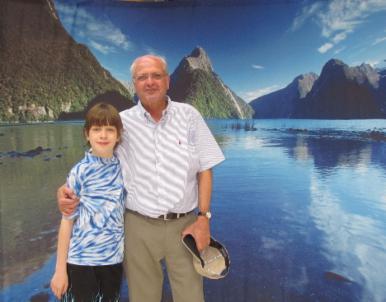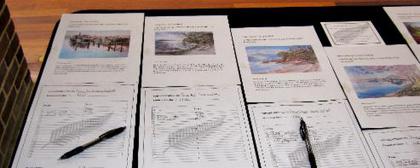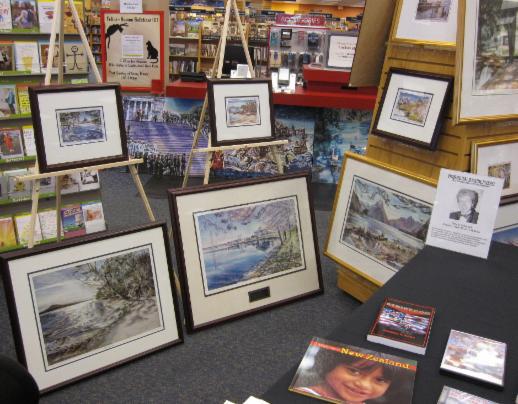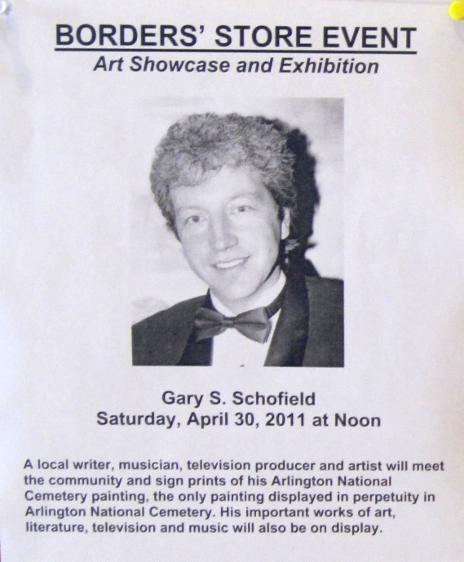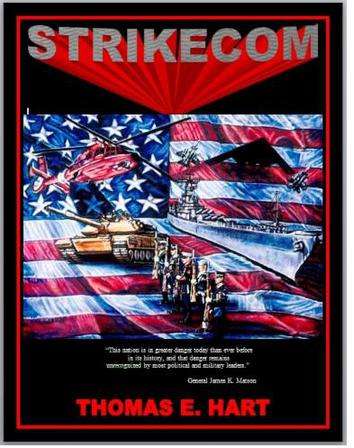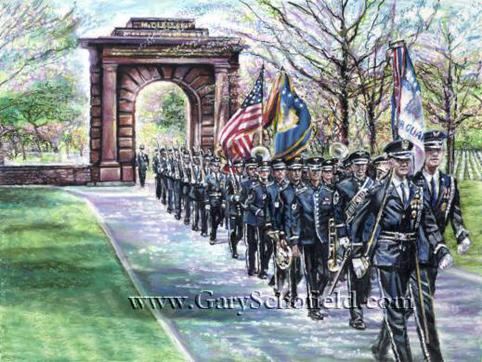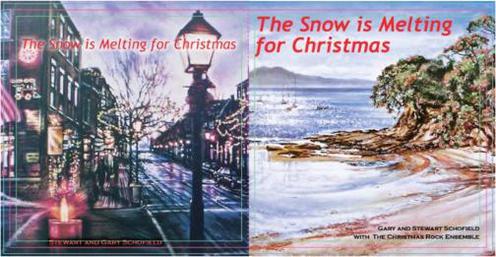
The Ferry Boats painting
Detail from The Washington National Cathedral painting
Gary S. Schofield is a writer, television producer, artist, composer, and musician. With a degree in Biochemistry, a career in the arts, and a keen interest in history, he has sought to add
this richness to all of his work..
He is also the president of The Global Concern, Inc.
Link http://www.theglobalconcern.org/
Link www.MeltingWorld.org
Recent Events
Commemoration of the Battle of the Somme and
Le Quesnoy
Depiction of the gallant actions of Lance-Corporal Scarfe by Gary S. Schofield
During a brief pause in the battle Scarfe looks directly at us, the viewer of the painting, and brings us into the moment.
Lance-Corporal Scarfe is looking into the future, into the eyes of his yet unborn son who would one day commission this work, and we are drawn into the solemn past as we commemorate and pledge never to forget or to repeat the dreadful Battle of the Somme.
Lance-Corporal Edward R. F. Scarfe's heroic and gallant actions during the Battle of the Somme won him the Distinguished Conduct Medal
His brave actions and initiative, while armed with a Lewis Gun, resulted in his single-handedly retaking a German Trench. Although wounded he further continued his leadership and military actions.Lance-Corporal Scarfe would then continue his service and military contribution at the Battle of Le Quesnoy.
At a time when the frequency of civilian casualties has become so horrendous and even expected in the Middle East we should all reflect upon our battle tactics and the WWI Battle of Le Quesnoy.
In the last days of WWI New Zealanders had to make the decision to destroy the walled city of Le Quesnoy by bombardment and ensure victory (but with great loss of civilian life) or sacrifice, in an assault to storm the town and save the civilians. The New Zealanders, at cost to themselves, assaulted the walls and liberated the town without the loss of civilian life.
To this day the people of Le Quesnoy are grateful to NZ and those brave young men who lost their lives in such a heroic way, commemorate ANZAC day and have declared Cambridge, New Zealand their sister city across the World.
During a brief pause in the battle Scarfe looks directly at us, the viewer of the painting, and brings us into the moment.
Lance-Corporal Scarfe is looking into the future, into the eyes of his yet unborn son who would one day commission this work, and we are drawn into the solemn past as we commemorate and pledge never to forget or to repeat the dreadful Battle of the Somme.
Lance-Corporal Edward R. F. Scarfe's heroic and gallant actions during the Battle of the Somme won him the Distinguished Conduct Medal
His brave actions and initiative, while armed with a Lewis Gun, resulted in his single-handedly retaking a German Trench. Although wounded he further continued his leadership and military actions.Lance-Corporal Scarfe would then continue his service and military contribution at the Battle of Le Quesnoy.
At a time when the frequency of civilian casualties has become so horrendous and even expected in the Middle East we should all reflect upon our battle tactics and the WWI Battle of Le Quesnoy.
In the last days of WWI New Zealanders had to make the decision to destroy the walled city of Le Quesnoy by bombardment and ensure victory (but with great loss of civilian life) or sacrifice, in an assault to storm the town and save the civilians. The New Zealanders, at cost to themselves, assaulted the walls and liberated the town without the loss of civilian life.
To this day the people of Le Quesnoy are grateful to NZ and those brave young men who lost their lives in such a heroic way, commemorate ANZAC day and have declared Cambridge, New Zealand their sister city across the World.
Present day Le Quesnoy
I am pleased and proud to be honoured by Her Majesty the Queen who has appointed me a Member of the New Zealand Order of Merit, an order of chivalry in the NZ Honours System. My service to the Arts and to NZ-US Relations were cited.
There is no better service, in my mind, than helping to improve relations between countries.
With respect to New Zealand I have reposted the painting of the NZ Embassy in Washington, D.C. and a speech by Dr. David Walker, from my exhibition there in 2002.
Introductory remarks by Dr. David Walker
Gary Schofield Exhibition Reception
New Zealand Embassy
9 December 2002
I am pleased and proud to be honoured by Her Majesty the Queen who has appointed me a Member of the New Zealand Order of Merit, an order of chivalry in the NZ Honours System. My service to the Arts and to NZ-US Relations were cited.
There is no better service, in my mind, than helping to improve relations between countries.
With respect to New Zealand I have reposted the painting of the NZ Embassy in Washington, D.C. and a speech by Dr. David Walker, from my exhibition there in 2002.
Introductory remarks by Dr. David Walker
Gary Schofield Exhibition Reception
New Zealand Embassy
9 December 2002
Good evening and welcome to the New Zealand Embassy. I am
pleased to welcome you to this reception in honour of artist Gary Schofield and
to mark his “Thread of Life” Exhibition currently on display here at the
Embassy.
As an aside I should not that despite the snow storm ewe managed to keep our doors open all last week- which is just as well as the height of the storm on Thursday, Gary stomping snow from his boots managed to make it here to deliver the final piece of his exhibition, true dedication we hope you will all appreciate!
Gary has long been a “friend of the Embassy” and we are very pleased that we are in a position not only to host this event on his behalf, but to display his works in our public spaces. Many of you here will be familiar with his work, not least of which is his painting of the Chancery that has pride of place in out main reception area.. A work commissioned by Ambassador Wood in his previous tour of duty here in Washington and it is fitting that he and his wife Rose are here with us tonight.
Some of the works on display have a New Zealand flavor while others will be familiar to anyone acquainted to life in Alexandria and Georgetown. In many of the works you will see the extent of the relationship that Gary has built with the defense community here in Washington and I think it would be fair to say that a number of his poignant works reflect and embrace this military theme period. I would ask you to take special note of one of Gary’s most recent pieces, a print of which is hanging just on the wall by the main entrance. The original; piece was unveiled at a Pentagon commemoration ceremony on September11 2002. It is dedicated to all those touched by the tragic events of last year.
Of course as the title indicates, we are fortunate this evening to experience a lifetime of Gary’s work. Throughout his successful career Gary has won two international Art awards and his works and prints can be found in several institutions including the General Accounting Office here in DC: The Bishops Museum, Hawaii the Marine Academy Texas and the New Zealand Academy of Fine Art.
It is always encouraging for us here at the Embassy when New Zealanders make a name for themselves in their chosen profession in the US particularly one as competitive as the World of Art. I invite you all to use this time to appreciate the pieces on display here this evening while enjoying some Kiwi hospitality in the process, but first I would like to invite the reason we are here this evening, artist Gary Schofield, to say a few words.
Dr. David Walker
Presentation to the Government of Turkey
As an aside I should not that despite the snow storm ewe managed to keep our doors open all last week- which is just as well as the height of the storm on Thursday, Gary stomping snow from his boots managed to make it here to deliver the final piece of his exhibition, true dedication we hope you will all appreciate!
Gary has long been a “friend of the Embassy” and we are very pleased that we are in a position not only to host this event on his behalf, but to display his works in our public spaces. Many of you here will be familiar with his work, not least of which is his painting of the Chancery that has pride of place in out main reception area.. A work commissioned by Ambassador Wood in his previous tour of duty here in Washington and it is fitting that he and his wife Rose are here with us tonight.
Some of the works on display have a New Zealand flavor while others will be familiar to anyone acquainted to life in Alexandria and Georgetown. In many of the works you will see the extent of the relationship that Gary has built with the defense community here in Washington and I think it would be fair to say that a number of his poignant works reflect and embrace this military theme period. I would ask you to take special note of one of Gary’s most recent pieces, a print of which is hanging just on the wall by the main entrance. The original; piece was unveiled at a Pentagon commemoration ceremony on September11 2002. It is dedicated to all those touched by the tragic events of last year.
Of course as the title indicates, we are fortunate this evening to experience a lifetime of Gary’s work. Throughout his successful career Gary has won two international Art awards and his works and prints can be found in several institutions including the General Accounting Office here in DC: The Bishops Museum, Hawaii the Marine Academy Texas and the New Zealand Academy of Fine Art.
It is always encouraging for us here at the Embassy when New Zealanders make a name for themselves in their chosen profession in the US particularly one as competitive as the World of Art. I invite you all to use this time to appreciate the pieces on display here this evening while enjoying some Kiwi hospitality in the process, but first I would like to invite the reason we are here this evening, artist Gary Schofield, to say a few words.
Dr. David Walker
Presentation to the Government of Turkey
His Excellency Ambassador Sedar Kilic, Gary Schofield and quests at the unveiling
Gallipoli 100 Commemorative Painting Beautifully Framed for the Presentation to the Government of Turkey
/
Schofield at Embassy
I am very pleased to enclose pictures you requested of this wonderful event, for the Turkish community.
It was such a pleasure meeting H.E. Ambassador Kiliç and the picture above even includes a magnificent image of Mustapha Ataturk.
Should you find this of interest, here are my reasons for the presentation:
The Turkey/ NZ/ US relationship is important in trade and tourism but also diplomatically at a time Turkey is beset by challenges and, not least, because of Turkey's role in the International War on Terrorism.
The presentation was not only about the present but also the past.
As you know WWI was a significant and formative event for a young New Zealand and for Australia which also suffered such a loss of young men. Gallipoli was also instrumental in the formation of modern Turkey through the victories of Mustapha Ataturk but what many NZers may not know is that Turkey, then the Ottoman Empire, sought an alliance with Britain. They certainly had been allies through their last conflict, the Crimean War but when Winston Churchill confiscated two Turkish dreadnoughts, they accepted the Goeben and the Breslau as a gift from Germany. Remaining under German command and with a German crew flying the Turkish flag these ships then immediately attacked Russia and brought Turkey into WWI on the German side.
The Gallipoli Turkey100 painting is one of four including; Great Britain, New Zealand and Australia and each underscore the perspective and humanity of the individual soldier and each are actual individuals. Behind the Turkish soldier is Cannakale.
Gallipoli is also important to the US. Not least as a military field of study for WWII invasions across the Pacific. It was not a coincidence Iwo Jima began on the same minute of the same day, of the same month exactly 30 years after Gallipoli, the first naval invasion in modern times.
It is also my considered belief that this is a time to strongly engage Turkey diplomatically..There is conflict on and within their borders and there is also the danger a conflict with Russia could draw NATO into a catastrophe. During the Clinton Administration I had the pleasure of working with the Secretary of Defense William Perry and saw, first hand, the success of those Preventive Defense policies of engagement. We should also be sympathetic to a country, once our enemy, who was magnanimous in victory, drawn into the patch work quilt of conflicting military, political and religious alliances of the Middle East. I believe we should also be mindful of the threat they perceive in our backing the Kurds.
Ambassador Killic himself is a charming, remarkable and important diplomatic and military figure. He advises us in the West to be constantly mindful of those dying terribly in Syria including those starving in Damascus. He hopes we will all make the cessation of hostilities a priority and does not want us to discuss this issue in the future as we did the preventable crimes of Bosnia.
The ambassador was also very pleased to receive this print of Gallipoli New Zealand 100.
I have been privileged to work on many commissions for the United States including the Pentagon September 11th painting.
Ambassador Kiliç has asked me to address the history for Turkey and the other 3 countries next April and I look forward to that event.
Best regards,
Gary S. Schofield
Public Appeal
The historic and beautifully sculptured Bronze of John Adshead was stolen from John several years ago. The work is distinctive, unique and easily recognizable. Any information concerning its whereabouts would be much appreciated.
I am very pleased to enclose pictures you requested of this wonderful event, for the Turkish community.
It was such a pleasure meeting H.E. Ambassador Kiliç and the picture above even includes a magnificent image of Mustapha Ataturk.
Should you find this of interest, here are my reasons for the presentation:
The Turkey/ NZ/ US relationship is important in trade and tourism but also diplomatically at a time Turkey is beset by challenges and, not least, because of Turkey's role in the International War on Terrorism.
The presentation was not only about the present but also the past.
As you know WWI was a significant and formative event for a young New Zealand and for Australia which also suffered such a loss of young men. Gallipoli was also instrumental in the formation of modern Turkey through the victories of Mustapha Ataturk but what many NZers may not know is that Turkey, then the Ottoman Empire, sought an alliance with Britain. They certainly had been allies through their last conflict, the Crimean War but when Winston Churchill confiscated two Turkish dreadnoughts, they accepted the Goeben and the Breslau as a gift from Germany. Remaining under German command and with a German crew flying the Turkish flag these ships then immediately attacked Russia and brought Turkey into WWI on the German side.
The Gallipoli Turkey100 painting is one of four including; Great Britain, New Zealand and Australia and each underscore the perspective and humanity of the individual soldier and each are actual individuals. Behind the Turkish soldier is Cannakale.
Gallipoli is also important to the US. Not least as a military field of study for WWII invasions across the Pacific. It was not a coincidence Iwo Jima began on the same minute of the same day, of the same month exactly 30 years after Gallipoli, the first naval invasion in modern times.
It is also my considered belief that this is a time to strongly engage Turkey diplomatically..There is conflict on and within their borders and there is also the danger a conflict with Russia could draw NATO into a catastrophe. During the Clinton Administration I had the pleasure of working with the Secretary of Defense William Perry and saw, first hand, the success of those Preventive Defense policies of engagement. We should also be sympathetic to a country, once our enemy, who was magnanimous in victory, drawn into the patch work quilt of conflicting military, political and religious alliances of the Middle East. I believe we should also be mindful of the threat they perceive in our backing the Kurds.
Ambassador Killic himself is a charming, remarkable and important diplomatic and military figure. He advises us in the West to be constantly mindful of those dying terribly in Syria including those starving in Damascus. He hopes we will all make the cessation of hostilities a priority and does not want us to discuss this issue in the future as we did the preventable crimes of Bosnia.
The ambassador was also very pleased to receive this print of Gallipoli New Zealand 100.
I have been privileged to work on many commissions for the United States including the Pentagon September 11th painting.
Ambassador Kiliç has asked me to address the history for Turkey and the other 3 countries next April and I look forward to that event.
Best regards,
Gary S. Schofield
Public Appeal
The historic and beautifully sculptured Bronze of John Adshead was stolen from John several years ago. The work is distinctive, unique and easily recognizable. Any information concerning its whereabouts would be much appreciated.
From New Zealand Woman's Weekly article
.
Link to TV
.
Sir Edmund Percival Hillary Portrait to Underscore Links with Waikato Region
Link to TV
.
Sir Edmund Percival Hillary Portrait to Underscore Links with Waikato Region
Read the delightful story detailing the creation of this portrait of Sir Ed.
.
ARTICLE IN EXPORT MAGAZINE
.
ARTICLE IN EXPORT MAGAZINE
.
US Quartermaster Corps Painting Completed and Unveiled
US Quartermaster Corps Painting Completed and Unveiled
Quartermaster General Kirklin and distinguished guests, it is a
great honor to be asked to create this work and I am very proud of it. I hope
this painting will come to represent the invaluable service of the
Quartermaster Corps not only for the military but also for the general public.
Everyone in this room knows that the great achievements, through history, of the U.S. military and the country would not have been possible without the Quartermaster, but I would like everyone else to be aware.
One of the reasons I was commissioned was because I am the artist who painted Private George Watson and the Pentagon September 11th painting. Just after September 11 was a difficult time and it was also a challenge working with a committee for 911. Napoleon himself said.
“Please, let me go to war against a committee.”
I am paraphrasing but he meant members of a group often do not have unity of idea and purpose and are even conflicted within themselves. So, what a pleasure it actually was to meet the dedicated ladies and gentlemen of the Quartermaster Foundation. Each was passionate about their cause but with a plethora of conflicting ideas and visions for the work. A strong faction thought Mifflin Hall should be the icon defining education and tradition, an other felt we should be looking forward, still another considered the Museum to be where the soul of the Quartermaster resides.
I was able to take everyone’s vision and ideas and include them all in the one work, creating a Quartermaster foundation upon which the past and future rests.
As we were leaving the meeting I noticed the flag in the entranceway trussed with supports and pins and asked Col. Barrett and Col. Vaughan to unravel the flag as if it were flying, stand on one leg in a confined space, hold a lamp in the other hand to rake across the flag highlighting the texture and image because, to me light is everything in a painting.
I can not imagine what these gentlemen, who did not know me very well at the time, were thinking but today they can see the result of their contribution and I would like to leave you all with the lines found in the text of :
Everyone in this room knows that the great achievements, through history, of the U.S. military and the country would not have been possible without the Quartermaster, but I would like everyone else to be aware.
One of the reasons I was commissioned was because I am the artist who painted Private George Watson and the Pentagon September 11th painting. Just after September 11 was a difficult time and it was also a challenge working with a committee for 911. Napoleon himself said.
“Please, let me go to war against a committee.”
I am paraphrasing but he meant members of a group often do not have unity of idea and purpose and are even conflicted within themselves. So, what a pleasure it actually was to meet the dedicated ladies and gentlemen of the Quartermaster Foundation. Each was passionate about their cause but with a plethora of conflicting ideas and visions for the work. A strong faction thought Mifflin Hall should be the icon defining education and tradition, an other felt we should be looking forward, still another considered the Museum to be where the soul of the Quartermaster resides.
I was able to take everyone’s vision and ideas and include them all in the one work, creating a Quartermaster foundation upon which the past and future rests.
As we were leaving the meeting I noticed the flag in the entranceway trussed with supports and pins and asked Col. Barrett and Col. Vaughan to unravel the flag as if it were flying, stand on one leg in a confined space, hold a lamp in the other hand to rake across the flag highlighting the texture and image because, to me light is everything in a painting.
I can not imagine what these gentlemen, who did not know me very well at the time, were thinking but today they can see the result of their contribution and I would like to leave you all with the lines found in the text of :
The Quartermaster Corps Painting
With the flight of an eagle the Quartermaster Corp sustains and supports the military might of the United States. The eagle itself is flanked and supported by education and heritage represented by Old Mifflin Hall, which stood as the heart, mind and soul of the Corps, and the U.S .Quartermaster Museum whose exhibits illustrate the mission of the Corps and honors the service of generations of Quartermaster Soldiers.
The Color Guard presents the ceremonial flags in the black and white of the past against the buff color of colonial times. The painting is the flag, replete with the icons of service, the sword and key, and even the ceremonial cannon from the Mexican War.
Established in 1775 the Quartermaster Corps has played an essential and sometimes unsung role in shaping the course of military achievements and history of the United States. Countless men and women have risked their lives in this service since George Washington chose Thomas Mifflin as the first Quartermaster General.
In ancient times the leader who could assemble, organize and feed an army of great size was usually victorious. This was as important as any battle tactic. Loss of supply can mean annihilation so, in military strategy, a maneuver to cut supply can even force a disadvantaged enemy to fight.
Private George Watson followed in this quartermaster tradition of centuries and made the supreme sacrifice. Private Watson, a member of the 29th Quartermaster Regiment, was aboard a ship hit by Japanese bombers off the coast of New Guinea on 8 March 1943. When the ship had to be abandoned, instead of seeking to save himself, he stayed in the water for a prolonged time courageously helping others. Weakened by his exertions, he was eventually dragged down by the sinking ship and was drowned. For his comrades he risked all, but with sad irony, lost even his own immortality for there were no descendants or even family to proudly receive his Congressional Medal of Honor awarded in 1997. Private Watson’s Medal of Honor can be found in the Quartermaster Museum along with other artifacts that tell the Quartermaster story, while the education of Mifflin Hall can be found in the hearts, minds and wisdom of serving and retired Quartermasters of today and tomorrow.
I believe this image illustrates the universality of our Comrades in Arms. Our services are linked with a bond of honor and self-sacrifice that transcends all endeavors and is painted in the symbols of the U.S. Quartermaster Corps.
With the flight of an eagle the Quartermaster Corp sustains and supports the military might of the United States. The eagle itself is flanked and supported by education and heritage represented by Old Mifflin Hall, which stood as the heart, mind and soul of the Corps, and the U.S .Quartermaster Museum whose exhibits illustrate the mission of the Corps and honors the service of generations of Quartermaster Soldiers.
The Color Guard presents the ceremonial flags in the black and white of the past against the buff color of colonial times. The painting is the flag, replete with the icons of service, the sword and key, and even the ceremonial cannon from the Mexican War.
Established in 1775 the Quartermaster Corps has played an essential and sometimes unsung role in shaping the course of military achievements and history of the United States. Countless men and women have risked their lives in this service since George Washington chose Thomas Mifflin as the first Quartermaster General.
In ancient times the leader who could assemble, organize and feed an army of great size was usually victorious. This was as important as any battle tactic. Loss of supply can mean annihilation so, in military strategy, a maneuver to cut supply can even force a disadvantaged enemy to fight.
Private George Watson followed in this quartermaster tradition of centuries and made the supreme sacrifice. Private Watson, a member of the 29th Quartermaster Regiment, was aboard a ship hit by Japanese bombers off the coast of New Guinea on 8 March 1943. When the ship had to be abandoned, instead of seeking to save himself, he stayed in the water for a prolonged time courageously helping others. Weakened by his exertions, he was eventually dragged down by the sinking ship and was drowned. For his comrades he risked all, but with sad irony, lost even his own immortality for there were no descendants or even family to proudly receive his Congressional Medal of Honor awarded in 1997. Private Watson’s Medal of Honor can be found in the Quartermaster Museum along with other artifacts that tell the Quartermaster story, while the education of Mifflin Hall can be found in the hearts, minds and wisdom of serving and retired Quartermasters of today and tomorrow.
I believe this image illustrates the universality of our Comrades in Arms. Our services are linked with a bond of honor and self-sacrifice that transcends all endeavors and is painted in the symbols of the U.S. Quartermaster Corps.
Presented to Gary S. Schofield
Life-size bronze of 2nd Maaori King unveiled at the Waikato Museum representing a common national heritage and future
LINK TO HE TUKU TAONGA TE PAKOKO RAUWHERO O KIINGI TAAWHIAO
King Taawhiao Matutaera Pootatau Te Wherowhero
Life-size bronze of 2nd Maaori King unveiled at the Waikato Museum representing a common national heritage and future
LINK TO HE TUKU TAONGA TE PAKOKO RAUWHERO O KIINGI TAAWHIAO
King Taawhiao Matutaera Pootatau Te Wherowhero
LINK TO HE TUKU TAONGA TE PAKOKO RAUWHERO O KIINGI TAAWHIAO
Tawhiao+-+He+Tuku+Taonga
Tawhiao+-+He+Tuku+Taonga.doc
Microsoft Word document [47.5 KB]
Tawhiao+-+He+Tuku+Taonga
Tawhiao+-+He+Tuku+Taonga.doc
Microsoft Word document [47.5 KB]
King Taawhiao Matutaera Pootatau Te Wherowhero
Speech given by Gary S. Schofield
Whatumoana, Te Whirinaki a Te Kingii, people of Tainui and Ngati Wairere, Mayor and distinguished guests it is a great honour for me to be here today and my sculpture of King Taawhiao Tukaroto Matutaera Pootatau Te WheroWhero presented, in effect, to all of us.
King Taawhiao was a visionary. He was indeed the epitome of the proud Maori warrior tradition but in an extraordinarily way because he believed in non-violent resistance.
King Taawhiao said;
“War always had its price and the price was always higher than expected. The result of war is that things become like decaying, old dried flax leaves. Let the person who raises war beware, for he must pay the price. "
and as John Kennedy would say 100 years later in the Nuclear Age:
“If we do not put an end to war, war will put an end to us”
King Taawhiao knew the answer was justice and reconciliation and quite rightly predicted the Maori People would one day find restitution for the wrongs they had suffered.
Imagine this impressive visage in the heart of the 19 th Century British Empire because that is exactly where he went 132 years ago. He took his grievances personally to Queen Victoria, endured the perilous voyage, the financial risk to his people, and gloriously failed but he set his people and his descendants on a course where they would ultimately prevail.
The entire theme of the Queen Elizabeth II’s last Christmas speech was reconciliation. We live in a time as fractious as the 19 th Century yet we are all stronger and wiser unified and together.
As such, it is very gracious of Maori to accept this sculpture precisely because I am Non-Maori and it has great importance, culturally and spiritually. This is not only tribute to a great king and leader, but in a way it represents, through art, that we are all New Zealanders taking pride in our shared heritage, unique to the World.
In King Taawhiao’s time the Schofields of Christchurch settled in the South. My ancestors were also the Stewarts and Brewers of Colonial Kawakawa in the North, Hotel Owners on each side of the main street. Thomas Dauntless Stewart had been born on the Sailing Ship “Dauntless ” on the voyage from Ireland and his son, my grandfather, was the telegraph officer in little towns of Rotorua, Waitara, Ruawai, and Pukekohe.
In 1941 as Postmaster of Tuakau he was friends with Princess Te Puea, They respected and admired each other and when he left she gave him her valuable green-stone pendant set in gold. Princess Te Puea would accomplish so much towards her grandfather, King Taawhiao’s vision.
I grew up in Hamilton and attended Southwell School with King Tuhiteia, benefiting from my Pakeha education but also the education that makes all of us New Zealanders: self reliant, egalitarian, unique with a belief in community, love of music and art. I learned the art of Moko from the primary source. I had access to the museum collection and, through the curator of the Auckland Museum, the 19 th Century preserved tattooed heads themselves.
I began this project nearly 30 years ago and worked for years perfecting the extraordinary 19th Century art form of Maori Moko. The King, Elders and Master Carver studied the bronze for weeks before endorsing the work. And I believe the consciousness of our country has risen and today’s understanding between Maori and Non-Maori will make this an important historical presentation.
Now, the sculpture and symbol will remain central to the Waikato Museum and its mission for all of us and our shared future.
Tena koto
Tena koto
Tena koto katoa
Link to Waikato Museum feature
Link to TV 3 feature
Link to "The Arts on Sunday" feature
Link to Jim Mora Show interview
Link to photography of Trevor N. DuPuy, military strategist and historian
Gallipoli in the USA with Great Britain, Turkey Australia and New Zealand
Speech given by Gary S. Schofield
Whatumoana, Te Whirinaki a Te Kingii, people of Tainui and Ngati Wairere, Mayor and distinguished guests it is a great honour for me to be here today and my sculpture of King Taawhiao Tukaroto Matutaera Pootatau Te WheroWhero presented, in effect, to all of us.
King Taawhiao was a visionary. He was indeed the epitome of the proud Maori warrior tradition but in an extraordinarily way because he believed in non-violent resistance.
King Taawhiao said;
“War always had its price and the price was always higher than expected. The result of war is that things become like decaying, old dried flax leaves. Let the person who raises war beware, for he must pay the price. "
and as John Kennedy would say 100 years later in the Nuclear Age:
“If we do not put an end to war, war will put an end to us”
King Taawhiao knew the answer was justice and reconciliation and quite rightly predicted the Maori People would one day find restitution for the wrongs they had suffered.
Imagine this impressive visage in the heart of the 19 th Century British Empire because that is exactly where he went 132 years ago. He took his grievances personally to Queen Victoria, endured the perilous voyage, the financial risk to his people, and gloriously failed but he set his people and his descendants on a course where they would ultimately prevail.
The entire theme of the Queen Elizabeth II’s last Christmas speech was reconciliation. We live in a time as fractious as the 19 th Century yet we are all stronger and wiser unified and together.
As such, it is very gracious of Maori to accept this sculpture precisely because I am Non-Maori and it has great importance, culturally and spiritually. This is not only tribute to a great king and leader, but in a way it represents, through art, that we are all New Zealanders taking pride in our shared heritage, unique to the World.
In King Taawhiao’s time the Schofields of Christchurch settled in the South. My ancestors were also the Stewarts and Brewers of Colonial Kawakawa in the North, Hotel Owners on each side of the main street. Thomas Dauntless Stewart had been born on the Sailing Ship “Dauntless ” on the voyage from Ireland and his son, my grandfather, was the telegraph officer in little towns of Rotorua, Waitara, Ruawai, and Pukekohe.
In 1941 as Postmaster of Tuakau he was friends with Princess Te Puea, They respected and admired each other and when he left she gave him her valuable green-stone pendant set in gold. Princess Te Puea would accomplish so much towards her grandfather, King Taawhiao’s vision.
I grew up in Hamilton and attended Southwell School with King Tuhiteia, benefiting from my Pakeha education but also the education that makes all of us New Zealanders: self reliant, egalitarian, unique with a belief in community, love of music and art. I learned the art of Moko from the primary source. I had access to the museum collection and, through the curator of the Auckland Museum, the 19 th Century preserved tattooed heads themselves.
I began this project nearly 30 years ago and worked for years perfecting the extraordinary 19th Century art form of Maori Moko. The King, Elders and Master Carver studied the bronze for weeks before endorsing the work. And I believe the consciousness of our country has risen and today’s understanding between Maori and Non-Maori will make this an important historical presentation.
Now, the sculpture and symbol will remain central to the Waikato Museum and its mission for all of us and our shared future.
Tena koto
Tena koto
Tena koto katoa
Link to Waikato Museum feature
Link to TV 3 feature
Link to "The Arts on Sunday" feature
Link to Jim Mora Show interview
Link to photography of Trevor N. DuPuy, military strategist and historian
Gallipoli in the USA with Great Britain, Turkey Australia and New Zealand
Left to Right: Hon. Consul General of Turkey, Mona Sunshine, British Consul General, Jeremy Pilmore-Bedford, Former Consul General of Australia, Ian Wing, New Zealand Army W.O. Evan Windlerborn, Gary Schofield, speaking, Hon. Consul, New Zealand Ian Latham, Royal Australian Air Force, Aaron Thompson before a multinational audience at Gallipoli 100th.
The original Gallipoli Australia, 2015 will be on display in the Australian Embassy, Washington, D.C. while the original New Zealand Gallipoli was part of the War commemorative exhibition, Jonathan Grant Galleries, Auckland. and the image part of the promotion for NZ seat on the UN Security Council.
Gallipoli, Turkey 2015
The Gallipoli Campaign was a defining military event in the history of our NATO ally, Turkey. It was not only definitive in the defense of the country but also the campaign gave rise to the great leadership of Mustafa Ataturk
Gallipoli the flag and the soldier are depicted from the Turkish perspective in the 1915, WWI view over Canakkale, Gallipoli.
The original Gallipoli Australia, 2015 will be on display in the Australian Embassy, Washington, D.C. while the original New Zealand Gallipoli was part of the War commemorative exhibition, Jonathan Grant Galleries, Auckland. and the image part of the promotion for NZ seat on the UN Security Council.
Gallipoli, Turkey 2015
The Gallipoli Campaign was a defining military event in the history of our NATO ally, Turkey. It was not only definitive in the defense of the country but also the campaign gave rise to the great leadership of Mustafa Ataturk
Gallipoli the flag and the soldier are depicted from the Turkish perspective in the 1915, WWI view over Canakkale, Gallipoli.
This year I have been asked to the 100th Commemoration of the WWI Commemoration in Atlanta where US, Australian, New Zealand, Turkish and British delegations will pay their respects to those brave souls.
Gallipoli 100th Commemorative
Gallipoli 100th Commemorative
Gallipoli, 2015, Australia.
This work features Albert Jacka, the most decorated Australian at Gallipoli.The Gallipoli Campaign was to assure the independent identity of both Australia and New Zealand; therefore, the Gallipoli Medal partially eclipses the Union Jack, the British part of the Australian Flag. This medal clearly shows Simpson's donkey
representing the historic bravery and self-sacrifice of those tending for the many wounded in a battle whose casualties were,
per capita, unprecedented. Australians and New Zealanders suffered casualty rates higher than 80%.
25th April, the day of the amphibious landing in 1915, has become as important a
date for Australians and New Zealanders as the 4th July for the United States. Before the campaign evolved into a major infantry confrontation, Gallipoli was
Winston Churchill's dramatic naval initiative to force the Dardanelles, bombard
Constantinople, sail the Danube and even to threaten Vienna .
Failing, on February 19th this plan evolved into an infantry operation to secure
the peninsular from already-alert valiant Turkish defenders. The British did not
make the mistake of sending their allies to the wrong beach. ANZAC cove was the
only shelter from the certain destruction of the original,l planned landing. The
British themselves suffered terribly at Cape Helles, further south.
The poignant stance of the lone Australian soldier, Albert Jacka, presides over
Anzac Cove itself and the landing is painted in detail. Albert Jacka, of the 14th
Battalion, alone and in a one-man flanking maneuver, defeated an attack on
Courtney's Post and was awarded the Victoria Cross for his gallantry. The loss of
Quinn, Courtney or Steel's Post, perched precariously on the ridge above Monash
Valley, would have unraveled the entire allied line and threatened a complete
catastrophe.
Albert Jacka endured the horrendous campaign from the 26th April, 1915 until the
end and represents not only continuing bravery, (like many surviving ANZACs, he
went on to fight on the Western Front), but also represents the many, just like him,
who never fully recovered from the war and died young men.
As my grandfather, wounded at Gallipoli, said; "no one left Gallipoli unwounded."
The New Zealand painting features George W. Stewart, Auckland Mounted Rifles,
who also endured the entire campaign and was one of only 13 survivors of his
entire regiment. He was decorated by his own country and honored by the French
(who, as a country, also fought at Gallipoli). Upon receiving his orders for the
evacuation his last sad duty was to euthanize his faithful horse.
This work features Albert Jacka, the most decorated Australian at Gallipoli.The Gallipoli Campaign was to assure the independent identity of both Australia and New Zealand; therefore, the Gallipoli Medal partially eclipses the Union Jack, the British part of the Australian Flag. This medal clearly shows Simpson's donkey
representing the historic bravery and self-sacrifice of those tending for the many wounded in a battle whose casualties were,
per capita, unprecedented. Australians and New Zealanders suffered casualty rates higher than 80%.
25th April, the day of the amphibious landing in 1915, has become as important a
date for Australians and New Zealanders as the 4th July for the United States. Before the campaign evolved into a major infantry confrontation, Gallipoli was
Winston Churchill's dramatic naval initiative to force the Dardanelles, bombard
Constantinople, sail the Danube and even to threaten Vienna .
Failing, on February 19th this plan evolved into an infantry operation to secure
the peninsular from already-alert valiant Turkish defenders. The British did not
make the mistake of sending their allies to the wrong beach. ANZAC cove was the
only shelter from the certain destruction of the original,l planned landing. The
British themselves suffered terribly at Cape Helles, further south.
The poignant stance of the lone Australian soldier, Albert Jacka, presides over
Anzac Cove itself and the landing is painted in detail. Albert Jacka, of the 14th
Battalion, alone and in a one-man flanking maneuver, defeated an attack on
Courtney's Post and was awarded the Victoria Cross for his gallantry. The loss of
Quinn, Courtney or Steel's Post, perched precariously on the ridge above Monash
Valley, would have unraveled the entire allied line and threatened a complete
catastrophe.
Albert Jacka endured the horrendous campaign from the 26th April, 1915 until the
end and represents not only continuing bravery, (like many surviving ANZACs, he
went on to fight on the Western Front), but also represents the many, just like him,
who never fully recovered from the war and died young men.
As my grandfather, wounded at Gallipoli, said; "no one left Gallipoli unwounded."
The New Zealand painting features George W. Stewart, Auckland Mounted Rifles,
who also endured the entire campaign and was one of only 13 survivors of his
entire regiment. He was decorated by his own country and honored by the French
(who, as a country, also fought at Gallipoli). Upon receiving his orders for the
evacuation his last sad duty was to euthanize his faithful horse.
Gallipoli, 2015, New Zealand
The New Zealand Koru symbolizes rebirth from the wounds of the conflict and also the creation of a young country. In reflecting upon the future, at this 100th commemorative, we should all be reminded that those long- lost, brave, young men believed they suffered to end "a war to end all wars" and would not have wished their experiences upon their great- grandchildren, just as the stars of the Southern Cross leap from the canvas to commemorate those brave souls and the national heritage of many allied countries.
Gallipoli, 2015 for Great Britain
Although the grief suffering and great loss of life for the New Zealanders and Australians at Gallipoli one hundred years ago was to galvanize the spirit of nationhood and independence for those countries, the British suffered in greater numbers in the same campaign.
This year I have been asked to the 100th Commemoration of the WWI I commemoration in Atlanta where US, Australian New Zealand Turkish and British delegations will pay their respects to those brave souls.
The New Zealand Koru symbolizes rebirth from the wounds of the conflict and also the creation of a young country. In reflecting upon the future, at this 100th commemorative, we should all be reminded that those long- lost, brave, young men believed they suffered to end "a war to end all wars" and would not have wished their experiences upon their great- grandchildren, just as the stars of the Southern Cross leap from the canvas to commemorate those brave souls and the national heritage of many allied countries.
Gallipoli, 2015 for Great Britain
Although the grief suffering and great loss of life for the New Zealanders and Australians at Gallipoli one hundred years ago was to galvanize the spirit of nationhood and independence for those countries, the British suffered in greater numbers in the same campaign.
This year I have been asked to the 100th Commemoration of the WWI I commemoration in Atlanta where US, Australian New Zealand Turkish and British delegations will pay their respects to those brave souls.
My painting depicts the tragedy of the British landing at Cape Helles, Gallipoli with the ship,
River Clyde.
The U.S. Quartermaster Corps. Established 1775
River Clyde.
The U.S. Quartermaster Corps. Established 1775
Recently I was asked down to Fort Lee from Washington, D.C. and had the pleasure staying on the Army Base there. Logistics comprise often under-appreciated branches of the Armed Forces.
16 years ago I had been commissioned to research and write the story of Private Watson who was awarded the Congressional Medal of Honor by the President...actually an entire class of ship (the Watson Class) was named after him.
16 years ago I had been commissioned to research and write the story of Private Watson who was awarded the Congressional Medal of Honor by the President...actually an entire class of ship (the Watson Class) was named after him.
Schofield exibit with Congressional Medal of Honor
All these years later my painting depicting the events is still the introduction to the mandatory training for thousands of soldiers/ week at Fort Lee,. (20,000/ day walk past my 911 painting at the Pentagon) and the Board of the Quartermaster Heritage Foundation asked me down to commission a work that would define the entire Corps...its history, legacy and future...
Interestingly next to my work is Patton's story, his Jeep and personal effects.
Patton exhibit
.
Best wishes for 2016
Season's Greetings Everyone
Best wishes for 2016
Season's Greetings Everyone
Ice on the Potomac G. Schofield
Watch the free video here:
CHRISTMAS 2014
NEWS For 2014.
Life Size Bronze of King Tawhiao Te Wherowhero
the "Face of Kingitanga"
endorsed by King Tuheitia for
the 150th Commemoration of the City of Hamilton..
Watch the free video here:
CHRISTMAS 2014
NEWS For 2014.
Life Size Bronze of King Tawhiao Te Wherowhero
the "Face of Kingitanga"
endorsed by King Tuheitia for
the 150th Commemoration of the City of Hamilton..
Kiing Kiingi Tuheitia
The Future of War" from the book Future Vision
CLICK HERE FOR FUTURE VISION
was written by Gary Schofield at a time when some historians were even
CLICK HERE FOR FUTURE VISION
claiming "the end of history".
CLICK HERE FOR FUTURE VISION
Now, years later, check for yourself each and every prediction made in this paper.
Future Vision is an anthology that comprises the papers of some of the world's greatest minds, including Frederik Pohl and Richard A.Slaughter.
CLICK HERE FOR FUTURE VISION
Schofield Complete 2014 Lesson Guides now made available to students, teachers and the public alike.
was written by Gary Schofield at a time when some historians were even
CLICK HERE FOR FUTURE VISION
claiming "the end of history".
CLICK HERE FOR FUTURE VISION
Now, years later, check for yourself each and every prediction made in this paper.
Future Vision is an anthology that comprises the papers of some of the world's greatest minds, including Frederik Pohl and Richard A.Slaughter.
CLICK HERE FOR FUTURE VISION
Schofield Complete 2014 Lesson Guides now made available to students, teachers and the public alike.
CLICK HERE FOR FUTURE VISION
The_Future_of_War
The_Future_of_War.pdf
Adobe Acrobat document [317.1 KB]
The_Future_of_War
The_Future_of_War.pdf
Adobe Acrobat document [317.1 KB]
CLICK HERE FOR FUTURE VISION
The_Future_of_War
The_Future_of_War.pdf
Adobe Acrobat document [317.1 KB]
The_Future_of_War
The_Future_of_War.pdf
Adobe Acrobat document [317.1 KB]
Should you wish to view these important materials
...
click on this link
Schofield 2015 Gallipoli Commemorative Print in Auckland War Memorial Museum, New Zealand
Lake Braddock Orchestra's extraordinary achievements in Schofield presentation
Link to Lake Braddock Orchestra feature
Gallipoli Print featured at the ANZAC Commemoration Atlanta, Georgia
...
click on this link
Schofield 2015 Gallipoli Commemorative Print in Auckland War Memorial Museum, New Zealand
Lake Braddock Orchestra's extraordinary achievements in Schofield presentation
Link to Lake Braddock Orchestra feature
Gallipoli Print featured at the ANZAC Commemoration Atlanta, Georgia
click on this link
New_Dimension$27s_complete_lesson_guides_2014
New_Dimension$27s_complete_lesson_guides[...]
Adobe Acrobat document [864.6 KB]
New_Dimension$27s_complete_lesson_guides_2014
New_Dimension$27s_complete_lesson_guides[...]
Adobe Acrobat document [864.6 KB]
The Honorary Consul Ian Latham, NZ Consulate, presided
Education through art
100th Commemoration of ANZAC for New Zealand featured in WWI exhibition
WWW exhibition Link Here
Schofield Gallipoli Painting used for Georgetown University's 2014 ANZAC Lecture
100th Commemoration of ANZAC for New Zealand featured in WWI exhibition
WWW exhibition Link Here
Schofield Gallipoli Painting used for Georgetown University's 2014 ANZAC Lecture
Schofield tribute to Australia:
Birth of Australia
Arcs
Spring in Washington, D.C. is a remarkable time of the year. Here it is depicted in the
"Cherry Blossoms".
Spring in Washington, D.C. is a remarkable time of the year. Here it is depicted in the
"Cherry Blossoms".
"The Cherry Blossoms" Detail
A thousand delicate petals scatter the early morning light around the Washington DC tidal Basin. Such fleeting beauty brings a soft impermanence to the political life of Washington, D.C. and reminds the American people of the eternal cycles of life and season.
This sentiment is also part of the gift from the people of Japan for these 1,300 cherry trees, given in 1912, touch both countries.
The cherry is a member of the rose family but by any name, in either country, most who walk through this pink and white carpet will walk quietly, in ceremony
Cherry Blossoms haiku
Rebirth eternal
Fleeting in their fragile life
The sweet breath of spring
GSS
In the painting itself I have attempted to capture may of the Capital’s symbols: the stature of Washington, the wisdom of Jefferson and the knowledge of the Smithsonian are not only represented here but also their reflections.
Original painting and text by Gary S. Schofield
Best wishes to everyone and hope 2014 is, so far, all you wished it could be.
Don't forget to always visit www.MeltingWorld.org for unique perspectives on how our planet is also doing!
Schofield painting of the Cathedral's beautiful gothic style and extraordinary "Space Window" now on display at the Washington National Cathedral.
This sentiment is also part of the gift from the people of Japan for these 1,300 cherry trees, given in 1912, touch both countries.
The cherry is a member of the rose family but by any name, in either country, most who walk through this pink and white carpet will walk quietly, in ceremony
Cherry Blossoms haiku
Rebirth eternal
Fleeting in their fragile life
The sweet breath of spring
GSS
In the painting itself I have attempted to capture may of the Capital’s symbols: the stature of Washington, the wisdom of Jefferson and the knowledge of the Smithsonian are not only represented here but also their reflections.
Original painting and text by Gary S. Schofield
Best wishes to everyone and hope 2014 is, so far, all you wished it could be.
Don't forget to always visit www.MeltingWorld.org for unique perspectives on how our planet is also doing!
Schofield painting of the Cathedral's beautiful gothic style and extraordinary "Space Window" now on display at the Washington National Cathedral.
Nordic Goddess on the set of music video"Christmas By Myself" the single
The World's first Global Warming Christmas CD, now a collector's item is available at
SchofldART@aol.com or at www.EVNdirect.com..
SchofldART@aol.com or at www.EVNdirect.com..
"The Snow Is Melting For Christmas" by Gary and Stewart Schofield
"EARTH FROM SPACE" Painting
"EARTH FROM SPACE" Painting
On display at the THOMAS JEFFERSON SCHOOL FOR SCIENCE AND TECHNOLOGY, Virginia
View the painting near the planetarium. The complete original is very large at 8' X 30 and incorporates the constellations, plane of the ecliptic, planets and milky way galaxy accurately painted.
CAPTAIN PELOWSKI'S CHANGE OF COMMAND CEREMONY AND PRESENTATION
.
View the painting near the planetarium. The complete original is very large at 8' X 30 and incorporates the constellations, plane of the ecliptic, planets and milky way galaxy accurately painted.
CAPTAIN PELOWSKI'S CHANGE OF COMMAND CEREMONY AND PRESENTATION
.
SUFFOLK, Va. - Capt. Karl Leonard relieved Capt. Stash Pelkowski as commanding officer of the Coast Guard Reserve Unit Joint Staff Suffolk during a change of command ceremony Saturday in Suffolk.
.
.
Schofield print presentation
Read more LINK
Other press coverage
The change of command ceremony conveys to the officers, enlisted members and civilian employees members of the Coast Guard that although the authority of command is relinquished by a leader and is assumed by another, it is still maintained without interruption.
Special Presentation The French Art Shop Wellington, New Zealand.
After being painted 30 years ago, a portrait, damaged in the Christchurch Earthquake, was repaired and finished in front of patrons at the French Art Shop Ghuznee Street, Wellington
Read more LINK
Other press coverage
The change of command ceremony conveys to the officers, enlisted members and civilian employees members of the Coast Guard that although the authority of command is relinquished by a leader and is assumed by another, it is still maintained without interruption.
Special Presentation The French Art Shop Wellington, New Zealand.
After being painted 30 years ago, a portrait, damaged in the Christchurch Earthquake, was repaired and finished in front of patrons at the French Art Shop Ghuznee Street, Wellington
.
Schofield Lecture
NZIIA
Click here for the complete presentation
Schofield Lecture
NZIIA
Click here for the complete presentation
Click here for the complete presentation
Gary+Schofield+NZIIA+Address
Gary+Schofield+NZIIA+Address.pdf
Adobe Acrobat document [9.7 MB]
Gary+Schofield+NZIIA+Address
Gary+Schofield+NZIIA+Address.pdf
Adobe Acrobat document [9.7 MB]
Lt. Gen Rhys-Jones, Chief of Defence Forces, Gary S. Schofield
Lecture
The New Zealand Institute of International Affairs
5.30 PM, Wednesday, 21st August, 2013, Victoria University of Wellington, Rutherford House Lecture Theatre and Ground Foyer.
“Art in the History of Conflict”
LINK TO EVENT
Art is a vehicle and an opportunity for international diplomacy. It is also an introduction to anyone, at any level. New Zealand, as a country, has a disproportionately strong voice in International Affairs and, as with all countries, this is predicated upon our Art of War, Art of Diplomacy and our Art and Culture.
Gary Schofield will not only describe a personal journey, but also intertwine a history of warfare as much of his work is symbolic and represents thousands of years of conflict. To understand civilisation we surely also have to understand the nature of warfare.
Lecture
The New Zealand Institute of International Affairs
5.30 PM, Wednesday, 21st August, 2013, Victoria University of Wellington, Rutherford House Lecture Theatre and Ground Foyer.
“Art in the History of Conflict”
LINK TO EVENT
Art is a vehicle and an opportunity for international diplomacy. It is also an introduction to anyone, at any level. New Zealand, as a country, has a disproportionately strong voice in International Affairs and, as with all countries, this is predicated upon our Art of War, Art of Diplomacy and our Art and Culture.
Gary Schofield will not only describe a personal journey, but also intertwine a history of warfare as much of his work is symbolic and represents thousands of years of conflict. To understand civilisation we surely also have to understand the nature of warfare.
LINK TO EVENT
Art_in_the_history_of_conflict_Gary_Schofield_21_August
Art_in_the_history_of_conflict_Gary_Scho[...]
Adobe Acrobat document [806.8 KB]
Art_in_the_history_of_conflict_Gary_Schofield_21_August
Art_in_the_history_of_conflict_Gary_Scho[...]
Adobe Acrobat document [806.8 KB]
Schofield Proposal for the Dame Hilda Ross Bronze Sculpture
"Such a work that seeks to portray Dame Hilda’s: legislative achievements, especially for women and children, oratory, pioneering role as a woman leader, being a conductor and pianist, work in healthcare, stoicism during WWII, Hamilton becoming a city, the end of the Land Wars and settlement of the area, must also be a vehicle of expression, movement and grace honouring her many achievements, interests and humanity.
In many ways these humanities are a projection of self and my proposal creates a podium for her, not only as a speaker, but also for her as a conductor and orchestrator of her own achievements."
"Such a work that seeks to portray Dame Hilda’s: legislative achievements, especially for women and children, oratory, pioneering role as a woman leader, being a conductor and pianist, work in healthcare, stoicism during WWII, Hamilton becoming a city, the end of the Land Wars and settlement of the area, must also be a vehicle of expression, movement and grace honouring her many achievements, interests and humanity.
In many ways these humanities are a projection of self and my proposal creates a podium for her, not only as a speaker, but also for her as a conductor and orchestrator of her own achievements."
Pencil sketch
Wax 3D sketch
Dame Hilda Ross and the Children of New Zealand
Dame Hilda Ross and the Children of New Zealand
Children are not only just a segment of the population but in essence, and only a couple of generations, they comprise the population,
The two children bursting from the podium under Dame Hilda’s orchestration represent all New Zealanders benefiting from her improvements in health, education and welfare.
Washington, D.C. Hepatitis B Initiative
The two children bursting from the podium under Dame Hilda’s orchestration represent all New Zealanders benefiting from her improvements in health, education and welfare.
Washington, D.C. Hepatitis B Initiative
As a donor to this worthwhile cause I would remind everyone:
19th May is Hepatitis B Awareness Day. This deadly and latent disease must be addressed
Here are some of the pictures from the Awards Dinner:
19th May is Hepatitis B Awareness Day. This deadly and latent disease must be addressed
Here are some of the pictures from the Awards Dinner:
Awards included Dr. Gregory Pappas and Congressman Mark Kean with Key note speaker Dr. Nadine Garcia Dir of minority US Dept. Health and Human Services.
Schofield prints assist in fund raising
Schofield prints assist in fund raising
St. Paul's Commission
March 2013
It is an honour to be here Headmaster and thanks to you and to everyone for making me, and my son Stewart, so welcome.
While I have been high on my step-ladder painting this picture many an earnest, polite, young, smiling face has asked me:
"How many paintings have you done?
How many times have you been on TV?
Do you get nervous when you have to speak in front of all those people?"
"The secret is this;
the truth is no one is really listening to you.
You have to make them pay attention and, worst of all, they will forget everything you have said very quickly."
We do not really remember the speeches from our school days. We remember the education, we use it still everyday, but few actual speeches are remembered.
I remember James K. Baxter coming to St. Paul's to speak, (You can find his books in the classrooms of the United States. Stewart read them in Grade 1 and 2 in the US and It is easier to order them from Minnesota than a book shop in Hamilton) and one other gentleman who came here and said;
"You are not going to remember a single word of what I have to say."
See, it works; I made sure I remembered them.
It is such a privilege and opportunity to impress your ideas on anyone especially children, so I value that privilege and make the most of every opportunity.
"Civilisation is a race between education and catastrophe” said H.G. Wells.
H. G. Wells was not just a science fiction writer he also helped write the charter to the League of Nations that would later become our United Nations Charter.
So, you never know who will shape the future of our world.
According to Archbishop Moxon, who was here just the other day, St. Paul's is now shaping the future leaders of New Zealand, not only because of its standards of education. but also because we believe in values and character and causes greater than ourselves.
Not wishing to argue with the Archbishop I will take this a step further because I know New Zealand has a disproportionate voice in the World. How can barely 4 million people have a say in a world of 7 Billion, but we do because of our geopolitical situation and history but also because of our education and place in global institutions.
So, what is being taught here will echo around the World.
I know of no finer education than from this school but, more importantly, school days are only a small portion of your entire life, should you live a long, healthy, New Zealand lifestyle.
Teaching how to learn and the enjoyment of learning expands wisdom and imagination every day and over a lifetime, and, as Einstein said;
"Imagination is more important than knowledge."
The other question I have been asked is:
“What is it like being back here at St Paul's?
Honestly the answer has two parts:
Firstly, there is nothing like the New Zealand rapport among workmates, the irreverent New Zealand humour or working along side the teachers, staff and administration of St. Paul's. It reminded me of my unique experience working in New Zealand many years ago.
It is a cultural difference to the USA and remarkably, even though we think of our humour as so personal and an inherent, integral part of our souls, our humour is definitely cultural and learned.
The second part of the answer is more melancholy or perhaps philosophical:
Here we all are in this same place. We are all very real, flesh and blood but, just as real, were my headmaster, teachers and friends who are now plaques and cups and names on a board.
I am also responsible for one of those, the bronze bust of Reginald Hornsby in the Hornsby library. Remember to glance his way as you enter and leave.
Hornsby was a remarkable man. Commander of the Gurkhars in WWII, stoic and persistent he believed in this school, denied himself payment for his work and simply, this school would not be here without him.
If you read the book "A Venture in Faith" it recounts my meeting him at the end of his life.
I actually hitch-hiked down to Nelson with the clay head under my arm and set about capturing the essence of the man. He refereed to me back at St. Paul's as "your man Schofield" and the younger man and the older man got to know one other.
There are ghosts everywhere for me and I want you to know of them too.
One of Grant Lander's leadership strengths is his ability to understand this, to honour their memories and contributions, realising they still exist today and to incorporate them into the school of today, moving forward.
We are the sum of all the people who have touched us in life.
As for the painting itself, the Headmaster told me he looks forward to an annual art dedication with other artists and I politely smiled, but quietly thought “hopefully not”.
The other secret I am going to tell you is how I name my works:
“The Arlington National Cemetery” painting
“The Washington National Cathedral” painting
“The Pentagon Full Honors” painting
“The Congressional Medal of Honor” painting
I name them so no other artist can come along and try to do the same thing!
In this regards we unveil today “The St. Paul’s Collegiate School” the result of a letter I received from:
Lizzy Rajan
Brenna Cockrem
Liam O’Donoghue
and Jonty Wood.
I knew, with such a space and a canvas so large, I had to make a work that was impressive and had stature. It could not be understated so I have used impact, strong and dramatic perspective so, not only does the painting leap towards you and out of the canvas, but also you can walk towards and into it and become part of that scene.
Other than the black and white I have used only the three primary colours, red, yellow and blue in the simplest palette, to paint the work. As mammals we are alerted to those colours and we see them on our roads and in our lives, to caution, alert and inform us everyday.
This painting seizes a moment of our history.
Thank you Headmaster and thank you St. Paul’s for giving me this experience.
It is an honour to be here Headmaster and thanks to you and to everyone for making me, and my son Stewart, so welcome.
While I have been high on my step-ladder painting this picture many an earnest, polite, young, smiling face has asked me:
"How many paintings have you done?
How many times have you been on TV?
Do you get nervous when you have to speak in front of all those people?"
"The secret is this;
the truth is no one is really listening to you.
You have to make them pay attention and, worst of all, they will forget everything you have said very quickly."
We do not really remember the speeches from our school days. We remember the education, we use it still everyday, but few actual speeches are remembered.
I remember James K. Baxter coming to St. Paul's to speak, (You can find his books in the classrooms of the United States. Stewart read them in Grade 1 and 2 in the US and It is easier to order them from Minnesota than a book shop in Hamilton) and one other gentleman who came here and said;
"You are not going to remember a single word of what I have to say."
See, it works; I made sure I remembered them.
It is such a privilege and opportunity to impress your ideas on anyone especially children, so I value that privilege and make the most of every opportunity.
"Civilisation is a race between education and catastrophe” said H.G. Wells.
H. G. Wells was not just a science fiction writer he also helped write the charter to the League of Nations that would later become our United Nations Charter.
So, you never know who will shape the future of our world.
According to Archbishop Moxon, who was here just the other day, St. Paul's is now shaping the future leaders of New Zealand, not only because of its standards of education. but also because we believe in values and character and causes greater than ourselves.
Not wishing to argue with the Archbishop I will take this a step further because I know New Zealand has a disproportionate voice in the World. How can barely 4 million people have a say in a world of 7 Billion, but we do because of our geopolitical situation and history but also because of our education and place in global institutions.
So, what is being taught here will echo around the World.
I know of no finer education than from this school but, more importantly, school days are only a small portion of your entire life, should you live a long, healthy, New Zealand lifestyle.
Teaching how to learn and the enjoyment of learning expands wisdom and imagination every day and over a lifetime, and, as Einstein said;
"Imagination is more important than knowledge."
The other question I have been asked is:
“What is it like being back here at St Paul's?
Honestly the answer has two parts:
Firstly, there is nothing like the New Zealand rapport among workmates, the irreverent New Zealand humour or working along side the teachers, staff and administration of St. Paul's. It reminded me of my unique experience working in New Zealand many years ago.
It is a cultural difference to the USA and remarkably, even though we think of our humour as so personal and an inherent, integral part of our souls, our humour is definitely cultural and learned.
The second part of the answer is more melancholy or perhaps philosophical:
Here we all are in this same place. We are all very real, flesh and blood but, just as real, were my headmaster, teachers and friends who are now plaques and cups and names on a board.
I am also responsible for one of those, the bronze bust of Reginald Hornsby in the Hornsby library. Remember to glance his way as you enter and leave.
Hornsby was a remarkable man. Commander of the Gurkhars in WWII, stoic and persistent he believed in this school, denied himself payment for his work and simply, this school would not be here without him.
If you read the book "A Venture in Faith" it recounts my meeting him at the end of his life.
I actually hitch-hiked down to Nelson with the clay head under my arm and set about capturing the essence of the man. He refereed to me back at St. Paul's as "your man Schofield" and the younger man and the older man got to know one other.
There are ghosts everywhere for me and I want you to know of them too.
One of Grant Lander's leadership strengths is his ability to understand this, to honour their memories and contributions, realising they still exist today and to incorporate them into the school of today, moving forward.
We are the sum of all the people who have touched us in life.
As for the painting itself, the Headmaster told me he looks forward to an annual art dedication with other artists and I politely smiled, but quietly thought “hopefully not”.
The other secret I am going to tell you is how I name my works:
“The Arlington National Cemetery” painting
“The Washington National Cathedral” painting
“The Pentagon Full Honors” painting
“The Congressional Medal of Honor” painting
I name them so no other artist can come along and try to do the same thing!
In this regards we unveil today “The St. Paul’s Collegiate School” the result of a letter I received from:
Lizzy Rajan
Brenna Cockrem
Liam O’Donoghue
and Jonty Wood.
I knew, with such a space and a canvas so large, I had to make a work that was impressive and had stature. It could not be understated so I have used impact, strong and dramatic perspective so, not only does the painting leap towards you and out of the canvas, but also you can walk towards and into it and become part of that scene.
Other than the black and white I have used only the three primary colours, red, yellow and blue in the simplest palette, to paint the work. As mammals we are alerted to those colours and we see them on our roads and in our lives, to caution, alert and inform us everyday.
This painting seizes a moment of our history.
Thank you Headmaster and thank you St. Paul’s for giving me this experience.
The Gallipoli Painting
Gallipoli
The concept is to make the New Zealand Flag, the painting.
This flag is beautiful with its brilliant blue incorporating the Southern Cross and the Union Jack and, unfurled in the breeze, represents the sky, land, sea and background of the painting in all dimensions.
Gallipoli was to assure the independent identity of both New Zealand and Australia, therefore over the Union Jack I have painted the Gallipoli Medal itself. The medal clearly shows ANZAC and Simpson’s donkey representing the historic bravery and self sacrifice of those tending for the many wounded in a battle whose casualties were greater, per capita, than any other: New Zealanders received casualty rates higher then 90%.
To the left within the painting stands a lone soldier of Gallipoli. I have chosen George W. Stewart from the Auckland Mounted Rifles both for his poignant stance and because he endured the horrendous campaign from beginning to end. He was one of only 13 survivors of his entire regiment and was decorated by his own country and honoured by the French. Upon receiving orders for the evacuation his final, sad duty was to euthanise his faithful horse.
The soldier is painted in the back and white we remember through the images of this period and stands proudly and serenely with poppies painted at his feet.
Within the sweep and curl of the flag is ANZAC Cove itself flanked by the New Zealand Koru. The entire New Zealand and Australian landing is painted with detail.
The New Zealand flag then also becomes the sparkling Aegean Sea with its beautiful turquoise colour merged with the sepia of the historic ANZAC landing.
To capture the public’s imagination, for fund raising, the painting must be inspiring, historical and beautiful. This flag then also serves as a statement with impact shaping the ribbons of the medal, while the stars leap from the canvas commemorating these brave souls and our heritage.
New Zealand's beautiful St. Peter's Cathedral painted by GSS:
The concept is to make the New Zealand Flag, the painting.
This flag is beautiful with its brilliant blue incorporating the Southern Cross and the Union Jack and, unfurled in the breeze, represents the sky, land, sea and background of the painting in all dimensions.
Gallipoli was to assure the independent identity of both New Zealand and Australia, therefore over the Union Jack I have painted the Gallipoli Medal itself. The medal clearly shows ANZAC and Simpson’s donkey representing the historic bravery and self sacrifice of those tending for the many wounded in a battle whose casualties were greater, per capita, than any other: New Zealanders received casualty rates higher then 90%.
To the left within the painting stands a lone soldier of Gallipoli. I have chosen George W. Stewart from the Auckland Mounted Rifles both for his poignant stance and because he endured the horrendous campaign from beginning to end. He was one of only 13 survivors of his entire regiment and was decorated by his own country and honoured by the French. Upon receiving orders for the evacuation his final, sad duty was to euthanise his faithful horse.
The soldier is painted in the back and white we remember through the images of this period and stands proudly and serenely with poppies painted at his feet.
Within the sweep and curl of the flag is ANZAC Cove itself flanked by the New Zealand Koru. The entire New Zealand and Australian landing is painted with detail.
The New Zealand flag then also becomes the sparkling Aegean Sea with its beautiful turquoise colour merged with the sepia of the historic ANZAC landing.
To capture the public’s imagination, for fund raising, the painting must be inspiring, historical and beautiful. This flag then also serves as a statement with impact shaping the ribbons of the medal, while the stars leap from the canvas commemorating these brave souls and our heritage.
New Zealand's beautiful St. Peter's Cathedral painted by GSS:
Detail 1 St. Peter's
Detail 2 St. Peter's
Detail 3 St. Peter's
Detail 4 St. Peter's
911 2012
The Pentagon September 11 Painting
911 2012
The Pentagon September 11 Painting
The Pentagon, Concourse, Washington. DC
Washington National Cathedral Painting
Washington National Cathedral Painting
.
Detail
.
The Washington Cathedral Painting
Wherever you stand in the magnificent Washington National Cathedral the immaculate prisms of light and divine presence filter through the artistry of sculptors, painters, and artisans. The Washington National Cathedral painting has employed this neo-gothic architecture and light to create a majestic triptych.
The three elements of The Trinity shine in symbolism and project out of the painting towards every viewer. Arches and frames within frames intertwine a neo-gothic style, history and cathedra traditions with science and the achievements of the Apollo mission and lunar landing.
From the pillars draped by the indoor lighting of the cathedral, to the colors of the spectrum filtered through the beautiful stained glass work from each window, the painting seeks to capture each overlapping beam of light.
The moon rock from the Sea of Tranquility placed in the center of the work and surrounded by the stars inspires us all to contemplate our wondrous universe.
The universality of this cathedral is also represented in the painting: above the arches are found the flags of the United States of America. This is the National Cathedral in which all citizens can take pride and where everyone is welcome to worship or visit. Our country prides itself in freedom of religion and separation of church and state and this is a cathedral for everyone, revered around the World.
Painted in oils and oil pastel the painting captures the glaze and depth of light in a unique technique. The artist, Gary S. Schofield, has completed many great works in Washington, DC and overseas and prints of his work are helping to raise funds in repairing the earthquake damage to this magnificent cathedral.
Schofield print on permanent display in the
US Veterans Govt. Building, Minnesota
.
.
The Washington Cathedral Painting
Wherever you stand in the magnificent Washington National Cathedral the immaculate prisms of light and divine presence filter through the artistry of sculptors, painters, and artisans. The Washington National Cathedral painting has employed this neo-gothic architecture and light to create a majestic triptych.
The three elements of The Trinity shine in symbolism and project out of the painting towards every viewer. Arches and frames within frames intertwine a neo-gothic style, history and cathedra traditions with science and the achievements of the Apollo mission and lunar landing.
From the pillars draped by the indoor lighting of the cathedral, to the colors of the spectrum filtered through the beautiful stained glass work from each window, the painting seeks to capture each overlapping beam of light.
The moon rock from the Sea of Tranquility placed in the center of the work and surrounded by the stars inspires us all to contemplate our wondrous universe.
The universality of this cathedral is also represented in the painting: above the arches are found the flags of the United States of America. This is the National Cathedral in which all citizens can take pride and where everyone is welcome to worship or visit. Our country prides itself in freedom of religion and separation of church and state and this is a cathedral for everyone, revered around the World.
Painted in oils and oil pastel the painting captures the glaze and depth of light in a unique technique. The artist, Gary S. Schofield, has completed many great works in Washington, DC and overseas and prints of his work are helping to raise funds in repairing the earthquake damage to this magnificent cathedral.
Schofield print on permanent display in the
US Veterans Govt. Building, Minnesota
.
Gallipoli, Guadalcanal and Iwo Jima
by Gary S. Schofield
Most people are completely unaware of New Zealand’s role in the WWII battles of the Pacific both in geography, military strategy and the personal sacrifice fighting alongside US allies.
70 years ago New Zealand was a staging ground for the one of the most pivotal campaigns in the Pacific War: Guadalcanal in the Solomon Islands.
The Japanese had seized the Solomon Islands and were cutting the fragile, extended allied supply lines in the South Pacific. It was a battle that would determine the future of the war. It was campaign to turn the tide of the Japanese conquests but should Guadalcanal have failed the future of the entire Pacific Theatre would have been in doubt.
In a bold surprise attack the Allies captured Guadacanal and the vital airstrip and in one of the most crucial battles of the war had to hold it and press the counter attack against the might of Naval Air and Ground Forces.
Most people are completely unaware of New Zealand’s role in the WWII battles of the Pacific both in geography, military strategy and the personal sacrifice fighting alongside US allies.
70 years ago New Zealand was a staging ground for the one of the most pivotal campaigns in the Pacific War: Guadalcanal in the Solomon Islands.
The Japanese had seized the Solomon Islands and were cutting the fragile, extended allied supply lines in the South Pacific. It was a battle that would determine the future of the war. It was campaign to turn the tide of the Japanese conquests but should Guadalcanal have failed the future of the entire Pacific Theatre would have been in doubt.
In a bold surprise attack the Allies captured Guadacanal and the vital airstrip and in one of the most crucial battles of the war had to hold it and press the counter attack against the might of Naval Air and Ground Forces.
Japanese Prisoners of War from the Solomons being disembarked in New Zealand
US forces on Guadalcanal
There was so much conflict and disease and so many naval engagements alone with such a loss of men and material the nearby waters were named Iron Bottom Sound.
“We tied empty ration cans together and strung them out and around our foxholes so if the Japs were moving around us in the dark they would rattle the cans and we could open up with our rifles and machine guns. This happened almost every night because they were strongly entrenched in the jungle and all around us.
They tried to infiltrate our perimeter at night and bayonet our men. You could swear that every bush was moving…”
A Guadalcanal war diary
Many of the US forces had come fresh from the pastoral welcome of the quiet farms and small cities of New Zealand.
Some call that the most successful invasion ever and the small country was captivated by the wealth and charm of the infantry and marines. My mother, Nita Stewart, now in her 90s, well remembers those days;
US forces on Guadalcanal
There was so much conflict and disease and so many naval engagements alone with such a loss of men and material the nearby waters were named Iron Bottom Sound.
“We tied empty ration cans together and strung them out and around our foxholes so if the Japs were moving around us in the dark they would rattle the cans and we could open up with our rifles and machine guns. This happened almost every night because they were strongly entrenched in the jungle and all around us.
They tried to infiltrate our perimeter at night and bayonet our men. You could swear that every bush was moving…”
A Guadalcanal war diary
Many of the US forces had come fresh from the pastoral welcome of the quiet farms and small cities of New Zealand.
Some call that the most successful invasion ever and the small country was captivated by the wealth and charm of the infantry and marines. My mother, Nita Stewart, now in her 90s, well remembers those days;
"The Americans seemed to attend all the dances and even sent their transports over with escorts and chaperones, officers and military police to take us to the US camp at Pukekohe from Tuakau. "
It was a long shift working in the Post and Telegraph office during the day and at night my mother also worked in the US dehydration plant nearby processing and desiccating food for the Pacific Campaign.
She remembers Americans like Albert Hanson from Montana who lost his life in the Pacific.
The US forces also returned from combat to New Zealand for medical care, leave, rest and relaxation. They were generous well mannered, she remembers, and while she subsisted on NZ coupons they brought silk stockings and sweets by the carton.
In fact with the arrival of flotillas of ships came the US 37th, 43rd and 25th Infantry Divisions, the 1st, 2nd and 3rd Marine Divisions, the US Naval Hospitals, the 39th General US Army hospital and a plethora of entertainers and VIPs.
This alliance had been forged in the heat of WWI and underscored by New Zealand suffering one of the largest losses of male population per capita in that war making her islands almost indefensible.
I dedicate this speech to those who fought and also those who supported and held their breath. I want to talk about the legacy you have given to us. It is a very important legacy in the way that Civilization, throughout history, always takes your experiences and shapes them into an image, into a story, or into a memorial.
Civilization takes art and music, history and literature and has shaped an icon, some picture of you, but I believe your bravery and sacrifice reaches all of us and tells that story and in so doing creates a stronger society.
It is mindful of these parallels and symbols that reflect the universal histories of all nations that I also dedicate this painting of “Iwo Jima in the Snow” to those Americans in the Pacific. Set in the Nations capital covered in a white shroud those iconic figures represent universal valor.
Life is fragile and in some ways we are all history and I have found we are guilty of being caught, often, in re-telling an old play, and in replaying an old story:
Guadalcanal was the first amphibious landing of the war. August 7 1942.
Gallipoli the ANZAC campaign of WWI was on the minds of US military planners. Gallipoli was the first modern amphibious landing ever and, of course, a disaster.
The invasion of Guadalcanal was going to be Gallipoli reincarnated but done well…and it was… to the extent that of all the moments to launch the climatic amphibious assault of the war; Iwo Jima…
the same minute, of the same hour, of the same day, exactly 30 years later was chosen.
9AM on the 19th February 1915 Gallipoli
9AM on the 19th February 1945 Iwo Jima.
Gallipoli had been studied. It was studied as an example of all the things not to do when launching an invasion. Everything that could possibly go wrong with that invasion went wrong, according to the history books.
But the most striking thing about history is that it is often a parable to current times. We view the great events of our country’s history through the events of today. In this way we remake the image of Gallipoli and Iwo Jima every generation.
To my Grandfather’s generation Gallipoli was a defining moment in his country’s coming of age, in the unquestioning duty to fight alongside the undefeatable British Empire. Inspired by Lord Kitchener my Grandfather volunteered and joined a flood of youth propelled into the First World War, into the Great Adventure.
It was a long shift working in the Post and Telegraph office during the day and at night my mother also worked in the US dehydration plant nearby processing and desiccating food for the Pacific Campaign.
She remembers Americans like Albert Hanson from Montana who lost his life in the Pacific.
The US forces also returned from combat to New Zealand for medical care, leave, rest and relaxation. They were generous well mannered, she remembers, and while she subsisted on NZ coupons they brought silk stockings and sweets by the carton.
In fact with the arrival of flotillas of ships came the US 37th, 43rd and 25th Infantry Divisions, the 1st, 2nd and 3rd Marine Divisions, the US Naval Hospitals, the 39th General US Army hospital and a plethora of entertainers and VIPs.
This alliance had been forged in the heat of WWI and underscored by New Zealand suffering one of the largest losses of male population per capita in that war making her islands almost indefensible.
I dedicate this speech to those who fought and also those who supported and held their breath. I want to talk about the legacy you have given to us. It is a very important legacy in the way that Civilization, throughout history, always takes your experiences and shapes them into an image, into a story, or into a memorial.
Civilization takes art and music, history and literature and has shaped an icon, some picture of you, but I believe your bravery and sacrifice reaches all of us and tells that story and in so doing creates a stronger society.
It is mindful of these parallels and symbols that reflect the universal histories of all nations that I also dedicate this painting of “Iwo Jima in the Snow” to those Americans in the Pacific. Set in the Nations capital covered in a white shroud those iconic figures represent universal valor.
Life is fragile and in some ways we are all history and I have found we are guilty of being caught, often, in re-telling an old play, and in replaying an old story:
Guadalcanal was the first amphibious landing of the war. August 7 1942.
Gallipoli the ANZAC campaign of WWI was on the minds of US military planners. Gallipoli was the first modern amphibious landing ever and, of course, a disaster.
The invasion of Guadalcanal was going to be Gallipoli reincarnated but done well…and it was… to the extent that of all the moments to launch the climatic amphibious assault of the war; Iwo Jima…
the same minute, of the same hour, of the same day, exactly 30 years later was chosen.
9AM on the 19th February 1915 Gallipoli
9AM on the 19th February 1945 Iwo Jima.
Gallipoli had been studied. It was studied as an example of all the things not to do when launching an invasion. Everything that could possibly go wrong with that invasion went wrong, according to the history books.
But the most striking thing about history is that it is often a parable to current times. We view the great events of our country’s history through the events of today. In this way we remake the image of Gallipoli and Iwo Jima every generation.
To my Grandfather’s generation Gallipoli was a defining moment in his country’s coming of age, in the unquestioning duty to fight alongside the undefeatable British Empire. Inspired by Lord Kitchener my Grandfather volunteered and joined a flood of youth propelled into the First World War, into the Great Adventure.
Private Walter Schofield 1915
The image of the war then was one of a group of rugby teams sent overseas to play a series of games.
Just to give you some idea of the scale of this war: At the battle of the Somme the British casualties alone were 57,000, on the first day.
The Gallipoli idea itself was imaginative and Winston Churchill’s, then Lord of the Admiralty. :
To sail the British fleet though the Narrows of the Dardanelles, through the Sea of Marmara to bombard Constantinople and even then on through the Black Sea to Romania and along the Danube to bombard Vienna into submission.
How is that for a World War I plan?
Now think for a moment; The bombardment began on the 19th of February but the Kiwis and Aussies commemorate ANZAC day, the day of the actual invasion, on the 25th April.
So what do you think the enemy was doing for the next 2 months?… preparing!
This is precisely why General Holland M. Smith, (Howling Mad Smith he liked to be known) in command of the Iwo Jima marine attack force wanted at least 10 days of concentrated bombardment followed by an immediate assault.
The image of the war then was one of a group of rugby teams sent overseas to play a series of games.
Just to give you some idea of the scale of this war: At the battle of the Somme the British casualties alone were 57,000, on the first day.
The Gallipoli idea itself was imaginative and Winston Churchill’s, then Lord of the Admiralty. :
To sail the British fleet though the Narrows of the Dardanelles, through the Sea of Marmara to bombard Constantinople and even then on through the Black Sea to Romania and along the Danube to bombard Vienna into submission.
How is that for a World War I plan?
Now think for a moment; The bombardment began on the 19th of February but the Kiwis and Aussies commemorate ANZAC day, the day of the actual invasion, on the 25th April.
So what do you think the enemy was doing for the next 2 months?… preparing!
This is precisely why General Holland M. Smith, (Howling Mad Smith he liked to be known) in command of the Iwo Jima marine attack force wanted at least 10 days of concentrated bombardment followed by an immediate assault.
Gen. H.M. Smith
The specter of Gallipoli stalked amphibious invasions.
Gallipoli evolved from that naval plan in an extreme form of mission creep. There were no plans for infantry in this operation they were called for later to garrison the forts after Turkey surrendered. From a garrison they became an assault force to take Constantinople: The Turks would surrender. Russia could be supplied and strengthened. Germany would be forced to withdraw forces from the Western Front and the War could well be over.
The irony was that back in 1914 the Narrows were virtually defenseless just as Iwo Jima was exactly thirty years later.
This was not the incompetence of “ bombarding too soon before an invasion” as we are told. There was no invasion, that was Churchill’s naval plan failing. Any invasion had been considered costly back in November 1914 and requiring hundreds of thousands of troops. So how could it suddenly be possible to send only 75,000 comprising irregular troops picked for garrison duty to take over the country? That is the untold story of Gallipoli. Kiwis and Aussies weren’t even considered regular troops and yet they nearly did it. The commanders on the field were cursed by Gallipoli to their graves for incompetence and yet they nearly did it.
Kitchener was so convinced in the inferiority of the Turks that he did not even research their military doctrine. There were 60,000 trained troops of the once Ottoman Empire defending the Dardanelles.
The Turks were fighting for their homeland just as it would be at Iwo Jima. That was the intensity and the will to fight to the death.
The reality was a failure and a calamity with grievous loss of life. Russia remained separated and then collapsed into the Bolshevik Revolution in 1917. The Allies were then committed to more years of trench warfare on the Western Front and the loss of more hundreds of thousands of lives.
The profound nature of the war altered its image dramatically and shaped the character of the country because of the personal scale of the tragedy. It was not only the experiences of the soldiers that weaved their way into the fabric of the country but the very real and undiminished grief of everyone else left behind.
My Grandfather was wounded at Gallipoli but on my Stewart mother’s side of the family, every one of my Grandmothers three brothers fought at Gallipoli.
The specter of Gallipoli stalked amphibious invasions.
Gallipoli evolved from that naval plan in an extreme form of mission creep. There were no plans for infantry in this operation they were called for later to garrison the forts after Turkey surrendered. From a garrison they became an assault force to take Constantinople: The Turks would surrender. Russia could be supplied and strengthened. Germany would be forced to withdraw forces from the Western Front and the War could well be over.
The irony was that back in 1914 the Narrows were virtually defenseless just as Iwo Jima was exactly thirty years later.
This was not the incompetence of “ bombarding too soon before an invasion” as we are told. There was no invasion, that was Churchill’s naval plan failing. Any invasion had been considered costly back in November 1914 and requiring hundreds of thousands of troops. So how could it suddenly be possible to send only 75,000 comprising irregular troops picked for garrison duty to take over the country? That is the untold story of Gallipoli. Kiwis and Aussies weren’t even considered regular troops and yet they nearly did it. The commanders on the field were cursed by Gallipoli to their graves for incompetence and yet they nearly did it.
Kitchener was so convinced in the inferiority of the Turks that he did not even research their military doctrine. There were 60,000 trained troops of the once Ottoman Empire defending the Dardanelles.
The Turks were fighting for their homeland just as it would be at Iwo Jima. That was the intensity and the will to fight to the death.
The reality was a failure and a calamity with grievous loss of life. Russia remained separated and then collapsed into the Bolshevik Revolution in 1917. The Allies were then committed to more years of trench warfare on the Western Front and the loss of more hundreds of thousands of lives.
The profound nature of the war altered its image dramatically and shaped the character of the country because of the personal scale of the tragedy. It was not only the experiences of the soldiers that weaved their way into the fabric of the country but the very real and undiminished grief of everyone else left behind.
My Grandfather was wounded at Gallipoli but on my Stewart mother’s side of the family, every one of my Grandmothers three brothers fought at Gallipoli.
George H. Stewart
We were a nation of about a million. The DuPuy Institute for Military Research estimates a western nation can support an army of 5 percent from its’ total population: That is an army of 50,000. Casualties at Gallipoli approached 10,000 or about 1 in 5 of the country’s total potential army.
At Gallipoli the number of troops deployed about equaled the number of casualties, remarkably the number of casualties approached the number deployed.
This is almost unheard of in the history of warfare.
Below is a map of the General area of Gallipoli.
We were a nation of about a million. The DuPuy Institute for Military Research estimates a western nation can support an army of 5 percent from its’ total population: That is an army of 50,000. Casualties at Gallipoli approached 10,000 or about 1 in 5 of the country’s total potential army.
At Gallipoli the number of troops deployed about equaled the number of casualties, remarkably the number of casualties approached the number deployed.
This is almost unheard of in the history of warfare.
Below is a map of the General area of Gallipoli.
The general area of Gallipoli including ANZAC Landings
Here are the Dardanelles, the Narrows and the Sea of Marama leading off to Constantinople in the distance, the point where West meets East, where Europe meets Asia. Turkey even used to be called Asia Minor.
Terrain clearly was a factor in this battle.
The image of ANZAC at Gallipoli to strategists of the time was a small arc on the coast.
Here are the Dardanelles, the Narrows and the Sea of Marama leading off to Constantinople in the distance, the point where West meets East, where Europe meets Asia. Turkey even used to be called Asia Minor.
Terrain clearly was a factor in this battle.
The image of ANZAC at Gallipoli to strategists of the time was a small arc on the coast.
Here is a sketch of Sir Ian Hamilton’s plan for capturing the Dardanelles. These are the Narrows and through this path lead to Constantinople. This whole area here had been mined and there were forts dotting the coast. The French were to land here. (Now I don’t know why we frequently leave the French out of discussions of Gallipoli but they played an important role.) The British were to take this area Cape Helles and the ANZACs were to land here and sweep across this easy terrain and seal off the peninsular. There was another landing up north comprising one man, Bernard Freyberg, who swam to Bulair and lit flares on the beach as a successful diversion.
Now I grew up believing this operation was such a bungle that they even landed us on the wrong beach. Well the British Navy of the time ruled the waves and prided itself on its ability to navigate and these were familiar waters. If you read the reports Hamilton was getting you see all this area, Sari Bair, was pitted with artillery covering that landing furthermore this area had been cut with trenches and barbed wire. There was only one place relatively sheltered and it was here at ANZAC cove.
Historians have said the wind and the currents must have carried them north but there weren’t any and if there were they would have dispersed them north in a general way. It was night, they couldn’t see each other and yet they all changed course simultaneously and went to this one spot. To me that means only one thing: they all had the same order. Hamilton was notorious for his secrecy. He changed the plan. He would rather have his men alive and on the wrong beach.
Mustapha Kemal the hero of the defense was not a general he was only a colonel who actually disobeyed battlefield orders and sent his regiment and then a whole division to defend ANZAC cove. He forced the ANZACs back into this small arc.
This small arc cut into the rugged terrain of hills and cliffs facing Chunak Bair and Koji Tepe, the crown of the Sari Bair heights.
So the ANZAC line was supported by high ground on each flank; on the right, Lone Pine, mostly in allied hands, and on the left Russel’s Top. Between them was Monash Gully the supply line to the entire position and constantly under fire from above. Russel’s Top on the left was undermined by the Turks holding Baby 700 and the Nek that connected them
The objective was to take the Sari Bair Ridge and both sides sent their young men to sacrifice in the age where the doctrine was mass and fire. The reality was the ANZACs had to win and press forward in a battle where each side was the same order of strength to the other but the New Zealanders and Australians had to assault the higher ground against entrenched positions.
Coarse volcanic sand, exactly 30 years latter would act as those rugged cliffs, advantaging the defender, slowing maneuver with an enemy above or an enemy below.
The Allies had more men and material but they were crammed into this little arc so at any point along this arc friend and foe were evenly matched. Just like Iwo Jima where the US had Air, Naval, men and material superiority but this was diminished by terrain and tactics.
The clear solution to this at Gallipoli was an invasion within an invasion and this is also precisely what happened at Okinawa 30 years latter at the Oroku peninsular, the last amphibious assault of WWII.
Hamilton invaded further north up the coast at Suvla Bay with three fresh divisions hoping, in surprise, to sweep up to the heights, unhinge the Turkish right and join forces with ANZAC.
A good plan but it wasn’t carried out. There was confusion, delay, no rush for the heights, no early assaults, hesitation of command long enough for Colonel Mustapha Kemal to redeploy.
To offset this redeployment Hamilton had ordered diversionary assaults back at ANZAC. One of those was made infamous in the movie Gallipoli and featured the futile charges of the 3rd Australian Light Horse Brigade at the Nek of Baby 700 but what is not commonly known were: the assaults by the 1st Australian Brigade taking the impregnable Turkish trenches at Lone Pine with hand to hand fighting and, New Zealanders capturing the Key to the Narrows itself, Chunak Bair, which is not bad for a diversion.
The invasion at Suvla ended in the loss of life assaulting Scimitar Hill and Australian and New Zealander pitting human courage against machine gun fire at Hill 60.
The reality was very different to the image. The men of ANZAC lived like cave dwellers in nooks cut out of the cliffs, constantly exposed to enemy fire and plagued by flies and dysentery. The water had to be brought from the Greek Islands and dragged up impossible terrain under fire and this was how, above Monash Gully that my Grandfather became a casualty.
It was the second day Walter Schofield had lain alone in the open trench. The sniper’s bullet had passed straight through his leg.
The merciless Turkish sun baked the air above the rocky ground as shrapnel and a hail of lead buzzed along with the incessant flies and the cries of combat.
It was 1915 the Great War, “the war to end all wars”. My Grandfather was a young man from a young country and there at ANZAC cove in the Dardanelles he came ashore in the invasion force. The Turks knew they were coming and the naval artillery barrage had merely alerted the enemy. He and his compatriots walked ashore into a blizzard of lead as sheets of enfilade machine gun fire rained upon the disorganized ranks.
Yard by yard the ANZACs fought their way up the cliffs, their objective the highest ground and Chunak Bair. Through the summer the First World War horrors of trench warfare had claimed thousands of lives. Disease wracked both sides.
What does a young man who is sure he will live forever, think about when he comes face to face with his own mortality, when he has seen his friends fallen like flotsam on the water, when he is swept away by political forces much stronger than he? I do not know what Private Walter Schofield thought about as he lay wounded in that trench day after day. Perhaps he thought of the many things he would have liked to have done. The family he would have wanted, the girls he wished he knew.
What I do know is that an old man with an all-knowing look in his eye tried to tell me, his grandson and his age at the time, what it was like. The medals, bayonet, photographs, a Gurkha’s knife were all merely props in a screen play to powerful to tell.
The medals, bayonet, photographs, a Gurkha’s knife were all merely props in a screen play to powerful to tell.
The image of Gallipoli changed over the next generation into one of Victory in Defeat. At Gallipoli there was a tactical victory in the casualty free retreat. Throughout history a retreating or routing army suffers terrible loss. Had the Turks attacked during the withdrawal the entire army could have been destroyed.
Also I would like to remind everyone the overlooked fact that we did successfully withdraw but left our friends the British there. They were still there down at Helles and they were attacked.
So there is more to this image of Gallipoli than a tactical victory in defeat. The celebration of a defeat is, in my view, the most profound wisdom. Very little is ever learnt in victory. Everything you did was probably brilliant when you have success it is usually only in failure that you learn.
New Zealanders resolved never to repeat such horror and looked to strong International forces to ensure it. Woodrow Wilson and the combatants sought to create a United Nations, International Institutions and strong International Law but failed and only a pale shadow, the League of Nations was born. In the first part of this Global war mostly soldiers were killed, in the second part, WW2, mostly civilians were killed.
Gallipoli went from a nightmare to becoming a field of study. It became a lesson of what not to do in invasions across the Pacific. Even Eisenhower studied Gallipoli in preparation for D-day.
The same courage it took to throw themselves at the entrenched machine gun positions of WW1 the marines had to have at Iwo Jima.
UNCOMMON valor was a common virtue the memorial reads and now it is 73 years ago that thousands of young American men set out to take that strategically important island.
It was vital for an airfield in the vast expanse of the Pacific. In the hands of the allies it was one stepping stone closer to the end of the war and a base for the B29s.
The Japanese knew the marines were coming and the island had become a giant fortress of block houses, pillboxes and caves. Mount Surabachi was the highest point and was situated at the southern most tip of the island but there were other high points and a high plateau all through here.
General Smith in command of the attack force wanted at least 10 days of concentrated bombardment but could only be spared four. After only three days of naval bombardment on February 19th, the invasion began. Wave after wave of marines fell from the 5th Division, 3rd Division the 4th division along a 2 mile stretch of beach. I have painted in red the fields of fire raking the landings. No retreat or maneuver was possible in the black coarse volcanic sand. The marines could only fight or de. They were in the open and under fire by as many as 22,000 dug in troops.
The battle was to be called the “worst since Gettysburg.”
The 28th marines from the 5th division were called upon to swing south and take Mount Surabachi, the high ground overlooking and commanding the entire island.
Now I grew up believing this operation was such a bungle that they even landed us on the wrong beach. Well the British Navy of the time ruled the waves and prided itself on its ability to navigate and these were familiar waters. If you read the reports Hamilton was getting you see all this area, Sari Bair, was pitted with artillery covering that landing furthermore this area had been cut with trenches and barbed wire. There was only one place relatively sheltered and it was here at ANZAC cove.
Historians have said the wind and the currents must have carried them north but there weren’t any and if there were they would have dispersed them north in a general way. It was night, they couldn’t see each other and yet they all changed course simultaneously and went to this one spot. To me that means only one thing: they all had the same order. Hamilton was notorious for his secrecy. He changed the plan. He would rather have his men alive and on the wrong beach.
Mustapha Kemal the hero of the defense was not a general he was only a colonel who actually disobeyed battlefield orders and sent his regiment and then a whole division to defend ANZAC cove. He forced the ANZACs back into this small arc.
This small arc cut into the rugged terrain of hills and cliffs facing Chunak Bair and Koji Tepe, the crown of the Sari Bair heights.
So the ANZAC line was supported by high ground on each flank; on the right, Lone Pine, mostly in allied hands, and on the left Russel’s Top. Between them was Monash Gully the supply line to the entire position and constantly under fire from above. Russel’s Top on the left was undermined by the Turks holding Baby 700 and the Nek that connected them
The objective was to take the Sari Bair Ridge and both sides sent their young men to sacrifice in the age where the doctrine was mass and fire. The reality was the ANZACs had to win and press forward in a battle where each side was the same order of strength to the other but the New Zealanders and Australians had to assault the higher ground against entrenched positions.
Coarse volcanic sand, exactly 30 years latter would act as those rugged cliffs, advantaging the defender, slowing maneuver with an enemy above or an enemy below.
The Allies had more men and material but they were crammed into this little arc so at any point along this arc friend and foe were evenly matched. Just like Iwo Jima where the US had Air, Naval, men and material superiority but this was diminished by terrain and tactics.
The clear solution to this at Gallipoli was an invasion within an invasion and this is also precisely what happened at Okinawa 30 years latter at the Oroku peninsular, the last amphibious assault of WWII.
Hamilton invaded further north up the coast at Suvla Bay with three fresh divisions hoping, in surprise, to sweep up to the heights, unhinge the Turkish right and join forces with ANZAC.
A good plan but it wasn’t carried out. There was confusion, delay, no rush for the heights, no early assaults, hesitation of command long enough for Colonel Mustapha Kemal to redeploy.
To offset this redeployment Hamilton had ordered diversionary assaults back at ANZAC. One of those was made infamous in the movie Gallipoli and featured the futile charges of the 3rd Australian Light Horse Brigade at the Nek of Baby 700 but what is not commonly known were: the assaults by the 1st Australian Brigade taking the impregnable Turkish trenches at Lone Pine with hand to hand fighting and, New Zealanders capturing the Key to the Narrows itself, Chunak Bair, which is not bad for a diversion.
The invasion at Suvla ended in the loss of life assaulting Scimitar Hill and Australian and New Zealander pitting human courage against machine gun fire at Hill 60.
The reality was very different to the image. The men of ANZAC lived like cave dwellers in nooks cut out of the cliffs, constantly exposed to enemy fire and plagued by flies and dysentery. The water had to be brought from the Greek Islands and dragged up impossible terrain under fire and this was how, above Monash Gully that my Grandfather became a casualty.
It was the second day Walter Schofield had lain alone in the open trench. The sniper’s bullet had passed straight through his leg.
The merciless Turkish sun baked the air above the rocky ground as shrapnel and a hail of lead buzzed along with the incessant flies and the cries of combat.
It was 1915 the Great War, “the war to end all wars”. My Grandfather was a young man from a young country and there at ANZAC cove in the Dardanelles he came ashore in the invasion force. The Turks knew they were coming and the naval artillery barrage had merely alerted the enemy. He and his compatriots walked ashore into a blizzard of lead as sheets of enfilade machine gun fire rained upon the disorganized ranks.
Yard by yard the ANZACs fought their way up the cliffs, their objective the highest ground and Chunak Bair. Through the summer the First World War horrors of trench warfare had claimed thousands of lives. Disease wracked both sides.
What does a young man who is sure he will live forever, think about when he comes face to face with his own mortality, when he has seen his friends fallen like flotsam on the water, when he is swept away by political forces much stronger than he? I do not know what Private Walter Schofield thought about as he lay wounded in that trench day after day. Perhaps he thought of the many things he would have liked to have done. The family he would have wanted, the girls he wished he knew.
What I do know is that an old man with an all-knowing look in his eye tried to tell me, his grandson and his age at the time, what it was like. The medals, bayonet, photographs, a Gurkha’s knife were all merely props in a screen play to powerful to tell.
The medals, bayonet, photographs, a Gurkha’s knife were all merely props in a screen play to powerful to tell.
The image of Gallipoli changed over the next generation into one of Victory in Defeat. At Gallipoli there was a tactical victory in the casualty free retreat. Throughout history a retreating or routing army suffers terrible loss. Had the Turks attacked during the withdrawal the entire army could have been destroyed.
Also I would like to remind everyone the overlooked fact that we did successfully withdraw but left our friends the British there. They were still there down at Helles and they were attacked.
So there is more to this image of Gallipoli than a tactical victory in defeat. The celebration of a defeat is, in my view, the most profound wisdom. Very little is ever learnt in victory. Everything you did was probably brilliant when you have success it is usually only in failure that you learn.
New Zealanders resolved never to repeat such horror and looked to strong International forces to ensure it. Woodrow Wilson and the combatants sought to create a United Nations, International Institutions and strong International Law but failed and only a pale shadow, the League of Nations was born. In the first part of this Global war mostly soldiers were killed, in the second part, WW2, mostly civilians were killed.
Gallipoli went from a nightmare to becoming a field of study. It became a lesson of what not to do in invasions across the Pacific. Even Eisenhower studied Gallipoli in preparation for D-day.
The same courage it took to throw themselves at the entrenched machine gun positions of WW1 the marines had to have at Iwo Jima.
UNCOMMON valor was a common virtue the memorial reads and now it is 73 years ago that thousands of young American men set out to take that strategically important island.
It was vital for an airfield in the vast expanse of the Pacific. In the hands of the allies it was one stepping stone closer to the end of the war and a base for the B29s.
The Japanese knew the marines were coming and the island had become a giant fortress of block houses, pillboxes and caves. Mount Surabachi was the highest point and was situated at the southern most tip of the island but there were other high points and a high plateau all through here.
General Smith in command of the attack force wanted at least 10 days of concentrated bombardment but could only be spared four. After only three days of naval bombardment on February 19th, the invasion began. Wave after wave of marines fell from the 5th Division, 3rd Division the 4th division along a 2 mile stretch of beach. I have painted in red the fields of fire raking the landings. No retreat or maneuver was possible in the black coarse volcanic sand. The marines could only fight or de. They were in the open and under fire by as many as 22,000 dug in troops.
The battle was to be called the “worst since Gettysburg.”
The 28th marines from the 5th division were called upon to swing south and take Mount Surabachi, the high ground overlooking and commanding the entire island.
Fields of Fire near Mount Surabachi, Iwo Jima
There were no front lines in the conventional sense because the Japanese were hidden, sometimes underground.
Twenty two thousand Japanese troops, prepared to fight to the death, resisted the marines. This was part of their homeland on that rocky ground rested the fate of their nation.
Through intense even hand to hand fighting, by day 5 of the invasion the peak was secured but by then on the island of Iwo jima more than 4,500 Americans had been killed or wounded.
It was 10 30 am, February 23rd, 1945 while a melee was still in progress the American flag was raised above Mount Surabachi. The flag was staffed by a length of iron pipe from a rain water cistern. Two thirds of the island was still enemy territory and losses would be terrible. This was before: the caves of Bloody Gorge, the Meat Grinder, Hill 382, Motoyama, Kitano Point, by the end of the battle the marines would suffer 26,000 casualties; that is more than the number of Japanese on the Island.
Whole battalions ceased to exist as losses were so great that units could no longer function. Of the 3,400 coming ashore with the 28th Regiment, 5th Marine Division, then Captain Haynes, who is with us today, recalls only 600 were standing when the battle closed.
News photographer for the associate press Joe Rosenthal had come ashore on the 22nd of February. Hearing the marines were already on the summit, he scaled the mountain in time to see those 6 struggling with the new, larger flag in the hard, rocky ground.
His picture became the most famous photograph of the war, with its dramatic composition, lighting and statement, of the faces of the marines hidden.
The 5 marines and a medical Corpsman were from left to right: Ira Hayes, Franklin Sousley, Michael Strank, John Bradley, Rene Gagnon and Harlon Block. Only Hays and Gagnon would leave the island physically unhurt but would later die alcoholics. Sousley, Strank and Block were killed before even learning of their fame.
As an aside I was recently talking with then Corporal Joseph Persing, 3rd Marine Division, a veteran of Iwo Jima who is looking towards his death and burial at Arlington Cemetery. He told me that where you are buried is determined by your medals or a purple heart if you were wounded and he had not been wounded. He was concerned.
It seems to me no one left Iwo Jima unwounded from the experience.
The picture itself struck such a chord with the Country that this larger than life image became a breathtaking sculpture in Arlington by Felix De Weldon. 32 foot high figures forever thrust the flag into the sky as a nation pledges not to forget.
I have painted the sculpture close to the angle the photograph depicts. Six faceless figures struggle in perfect composition, with a task much greater than they, but each with an individual humanity and a personal experience.
The sculpture is framed by the perennial evergreen pine needles. A strong modeling light rakes through the trees and dapples the snow in bursts tracing a contrasting pattern. The base of the sculpture and the entire field is draped in a shroud. Not a grave black shroud but a white shroud of snow and light and in the background the city of Washington DC.
Iwo Jima is a tropical volcanic ash covered island but the painting depicts a cold 19th February, winter’s day. This is because the image does not change and because those men and all those there were truly “men for all seasons”.
Both of these conflicts are now icons to courage and valor. The Gallipoli campaign became ANZAC day, in a way, Australia and New Zealand’s Independence Day: The celebration of a defeat, a red poppy representing the blood of an entire lost generation. The Iwo Jima sculpture: valor, companionship and triumph.
The red stripes of the American flag is the only red used in the painting. Is it not ironical how seldom the color red finds its way into our memorials?
Thank you
.
THOSE LARGE, BEAUTIFUL CANVAS PRINTS...
Just keep getting larger and better.
There were no front lines in the conventional sense because the Japanese were hidden, sometimes underground.
Twenty two thousand Japanese troops, prepared to fight to the death, resisted the marines. This was part of their homeland on that rocky ground rested the fate of their nation.
Through intense even hand to hand fighting, by day 5 of the invasion the peak was secured but by then on the island of Iwo jima more than 4,500 Americans had been killed or wounded.
It was 10 30 am, February 23rd, 1945 while a melee was still in progress the American flag was raised above Mount Surabachi. The flag was staffed by a length of iron pipe from a rain water cistern. Two thirds of the island was still enemy territory and losses would be terrible. This was before: the caves of Bloody Gorge, the Meat Grinder, Hill 382, Motoyama, Kitano Point, by the end of the battle the marines would suffer 26,000 casualties; that is more than the number of Japanese on the Island.
Whole battalions ceased to exist as losses were so great that units could no longer function. Of the 3,400 coming ashore with the 28th Regiment, 5th Marine Division, then Captain Haynes, who is with us today, recalls only 600 were standing when the battle closed.
News photographer for the associate press Joe Rosenthal had come ashore on the 22nd of February. Hearing the marines were already on the summit, he scaled the mountain in time to see those 6 struggling with the new, larger flag in the hard, rocky ground.
His picture became the most famous photograph of the war, with its dramatic composition, lighting and statement, of the faces of the marines hidden.
The 5 marines and a medical Corpsman were from left to right: Ira Hayes, Franklin Sousley, Michael Strank, John Bradley, Rene Gagnon and Harlon Block. Only Hays and Gagnon would leave the island physically unhurt but would later die alcoholics. Sousley, Strank and Block were killed before even learning of their fame.
As an aside I was recently talking with then Corporal Joseph Persing, 3rd Marine Division, a veteran of Iwo Jima who is looking towards his death and burial at Arlington Cemetery. He told me that where you are buried is determined by your medals or a purple heart if you were wounded and he had not been wounded. He was concerned.
It seems to me no one left Iwo Jima unwounded from the experience.
The picture itself struck such a chord with the Country that this larger than life image became a breathtaking sculpture in Arlington by Felix De Weldon. 32 foot high figures forever thrust the flag into the sky as a nation pledges not to forget.
I have painted the sculpture close to the angle the photograph depicts. Six faceless figures struggle in perfect composition, with a task much greater than they, but each with an individual humanity and a personal experience.
The sculpture is framed by the perennial evergreen pine needles. A strong modeling light rakes through the trees and dapples the snow in bursts tracing a contrasting pattern. The base of the sculpture and the entire field is draped in a shroud. Not a grave black shroud but a white shroud of snow and light and in the background the city of Washington DC.
Iwo Jima is a tropical volcanic ash covered island but the painting depicts a cold 19th February, winter’s day. This is because the image does not change and because those men and all those there were truly “men for all seasons”.
Both of these conflicts are now icons to courage and valor. The Gallipoli campaign became ANZAC day, in a way, Australia and New Zealand’s Independence Day: The celebration of a defeat, a red poppy representing the blood of an entire lost generation. The Iwo Jima sculpture: valor, companionship and triumph.
The red stripes of the American flag is the only red used in the painting. Is it not ironical how seldom the color red finds its way into our memorials?
Thank you
.
THOSE LARGE, BEAUTIFUL CANVAS PRINTS...
Just keep getting larger and better.
One of the Schofield prints for the Northrop Grumman Corporation
JUST DISCOVERED.. a video of the unveiling and commemoration of the Congressional Medal of Honor Painting at the US Army Quartermaster Museum
JUST DISCOVERED.. a video of the unveiling and commemoration of the Congressional Medal of Honor Painting at the US Army Quartermaster Museum
“It illuminates the story of Private Watson in the sense we use it in our values training.
Here we have a vignette for each day of the 7 army values.
This particular one represents selfless service:
Courage, essentially honor,
Putting yourself ahead of anyone or anything to save another soldier or sailor’s life.
That is what this painting will illuminate for all the thousands of soldiers who come through here on a weekly basis.
This is where the collections are kept.
This is where the army keeps its values, basically”.
Dr. Luther Hanson
Curator US Army Quartermaster Museum
WATCH: VIDEO, PAINTING, SPEECH, COMMEMORATION, DEDICATION HERE
Joel B. Hudson
Administrative Assistant to the Secretary of the Army
"It is indeed an honor and a privilege to present to the Quartermaster
Museum this painting of the heroic actions of Private Watson.
This is the home of Private Watson now:
It is the home of his medal
The home of his deed
The home of his painting."
LAST CHANCE
... to view the Schofield Exhibition in Fairfax County, Virginia, an outlying county near Washington, D.C..
through January 2012
Here we have a vignette for each day of the 7 army values.
This particular one represents selfless service:
Courage, essentially honor,
Putting yourself ahead of anyone or anything to save another soldier or sailor’s life.
That is what this painting will illuminate for all the thousands of soldiers who come through here on a weekly basis.
This is where the collections are kept.
This is where the army keeps its values, basically”.
Dr. Luther Hanson
Curator US Army Quartermaster Museum
WATCH: VIDEO, PAINTING, SPEECH, COMMEMORATION, DEDICATION HERE
Joel B. Hudson
Administrative Assistant to the Secretary of the Army
"It is indeed an honor and a privilege to present to the Quartermaster
Museum this painting of the heroic actions of Private Watson.
This is the home of Private Watson now:
It is the home of his medal
The home of his deed
The home of his painting."
LAST CHANCE
... to view the Schofield Exhibition in Fairfax County, Virginia, an outlying county near Washington, D.C..
through January 2012
Address:
King's Park Library
9000 Burke Lake Road
Burke, VA 22015-1683
LINK
.
Attended a fundraiser for Computer Clubhouse New Zealand at the New Zealand Embassy Washington, D.C.
This is an excellent educational program that allows chidren access to the world of creativity and communication this computer age offers.
.http://www.computerclubhouse.org.nz/ h
Vietnam Wall Painting
King's Park Library
9000 Burke Lake Road
Burke, VA 22015-1683
LINK
.
Attended a fundraiser for Computer Clubhouse New Zealand at the New Zealand Embassy Washington, D.C.
This is an excellent educational program that allows chidren access to the world of creativity and communication this computer age offers.
.http://www.computerclubhouse.org.nz/ h
Vietnam Wall Painting
Gary Schofield's striking painting was recently unveiled in November, 2011.
The painting features the lone honor guard, Brian S. King, standing in tribute at the dedication ceremony of the Vietnam Wall in November 1982, 29 years earlier, and captures the presence of a Washington D.C. memorial that means so much to so many people.
.
The Hepatitis B Initiative of Washington DC
Benefit Gala & Awards Dinner
Sunday, October 23, 2011
5:30p-6:30p- Cocktail Reception
6:30p-9:00p - Dinner and Program
Where:
China Garden •
Keynote Speaker:
The Honorable Howard K. Koh, MD, MPH
Assistant Secretary for Health
U.S. Department of Health and Human Services
Mistress of Ceremony:
Kathy Park - ABC7 & News Channel 8
Awards:
The Honorable Howard K. Koh, MD, MPH - Hep B Super Hero Award
Dr. Sang Tran - 2011 Community Service Award
Dr. Mark Li - 2011 Community Service Award
Dr. Benson Yu - 2011 Community Service Award
Dr. James Suh - 2011 Community Service Award
Dr. Chan-Hing Ma Ho - 2011 Community Service Award
Hepatitis B Initiative of Washington, D.C. (HBI-DC) is a non-profit
organization with a mission to provide Hepatitis B education, screenings and vaccinations to populations at risk, including Asian American, Pacific Islander and African communities.
One of the donated limited edition prints helping to raise money for this organization below:
The painting features the lone honor guard, Brian S. King, standing in tribute at the dedication ceremony of the Vietnam Wall in November 1982, 29 years earlier, and captures the presence of a Washington D.C. memorial that means so much to so many people.
.
The Hepatitis B Initiative of Washington DC
Benefit Gala & Awards Dinner
Sunday, October 23, 2011
5:30p-6:30p- Cocktail Reception
6:30p-9:00p - Dinner and Program
Where:
China Garden •
Keynote Speaker:
The Honorable Howard K. Koh, MD, MPH
Assistant Secretary for Health
U.S. Department of Health and Human Services
Mistress of Ceremony:
Kathy Park - ABC7 & News Channel 8
Awards:
The Honorable Howard K. Koh, MD, MPH - Hep B Super Hero Award
Dr. Sang Tran - 2011 Community Service Award
Dr. Mark Li - 2011 Community Service Award
Dr. Benson Yu - 2011 Community Service Award
Dr. James Suh - 2011 Community Service Award
Dr. Chan-Hing Ma Ho - 2011 Community Service Award
Hepatitis B Initiative of Washington, D.C. (HBI-DC) is a non-profit
organization with a mission to provide Hepatitis B education, screenings and vaccinations to populations at risk, including Asian American, Pacific Islander and African communities.
One of the donated limited edition prints helping to raise money for this organization below:
Gary S. Schofield's "The Canal, Georgetown"
1100 Wilson Blvd.
Rosslyn, VA 22209
New painting project
Watch a painting grow and develop in real time!
detail
1100 Wilson Blvd.
Rosslyn, VA 22209
New painting project
Watch a painting grow and develop in real time!
detail
September 11, 2011
Two large canvases depicting "The Pentagon Full Honors Ceremony" and "The Pentagon September 11th Painting" by Gary S. Schofield were on display at the Pentagon for the 10th Commemorative of 9-11.
Two large canvases depicting "The Pentagon Full Honors Ceremony" and "The Pentagon September 11th Painting" by Gary S. Schofield were on display at the Pentagon for the 10th Commemorative of 9-11.
The Pentagon September the 11th Painting
This painting was commissioned by the Department of Defense for the Pentagon and was completed before the first year commemoration.
The large, original work of mixed media, oil, pastel on board, by Gary S. Schofield was unveiled at the Pentagon on September 11, 2002.
The painting is dedicated to all those touched by the tragic event.
This image speaks very much for itself and also references the standards and symbols of both ancient civilizations and the strength and future of the United States.
The light rakes across this icon of unity, a golden medallion, and colors three of the flag's fifty stars with red. This is the only reference to the tragedy of that day as the painting is a testament to enduring strength and courage. Memories, painted in three dimensional chiaroscuro, are set as jewels into the Purple, the traditional color of power.
This courage is reflected by the selflessness and heroism of the day.
The United States flag, the Stars and Stripes, uncovers the rising eagle and forms its wings.
This painting was commissioned by the Department of Defense for the Pentagon and was completed before the first year commemoration.
The large, original work of mixed media, oil, pastel on board, by Gary S. Schofield was unveiled at the Pentagon on September 11, 2002.
The painting is dedicated to all those touched by the tragic event.
This image speaks very much for itself and also references the standards and symbols of both ancient civilizations and the strength and future of the United States.
The light rakes across this icon of unity, a golden medallion, and colors three of the flag's fifty stars with red. This is the only reference to the tragedy of that day as the painting is a testament to enduring strength and courage. Memories, painted in three dimensional chiaroscuro, are set as jewels into the Purple, the traditional color of power.
This courage is reflected by the selflessness and heroism of the day.
The United States flag, the Stars and Stripes, uncovers the rising eagle and forms its wings.
The Pentagon Full Honors Ceremony Painting
Each of the services of the Armed Forces of the United States, together with civilians, may wish to reflect upon The Pentagon Full Honors Ceremony painting during the 10th commemorative of the tragic events of September 11, 2001.
The image represents military and civilian alike all present at the Pentagon on that fateful day and their heroism and sacrifice, never to be forgotten.
Not only does the painting portray the dignity and honor in serving ones country, the Color Guard and Honor Guards of each of the services but also the County itself with its citizens and 56 flags of the States and Territories.
This image has been presented as a diplomatic symbol of alliance by successive Secretaries of Defense and it also represents centuries of military traditions and ideas.
Thousands of years ago, troops would form for battle in these lines. The king or leader would be there with his personal banner, held by his flag bearer or ensign. Most of the forces wouldhave a shield in their left hand and a weapon in their right so the king, had to trust the person he placed on his right. The right was the vulnerable side, the unshielded side. This has become the place of honor, and that is why The Stars and Stripes is seen to the right of all the other flags in the Color Guard.
A few centuries passed and in the Roman period these formations, or cohorts, became more structured. In the chaos and confusion of battle a soldier knew his set distance from the standard and so could easily rally.
Behind the cohorts was the last line of defense for the Roman army, the triarii, the spear bearers, and, in a 2,000 year parallel, taking the same position in the ceremony are the Flag Bearers of the US States and Territories.
In front of the cohorts, taking the ancient position of skirmishers, are the commanders of each of the Honor Guards. They are: the Army, the Marines, the Navy, the Air Force and the Coast Guard.
By the end of the Feudal period, the king or queen was becoming so powerful that they could maintain their own standing army. This, together with the flourishing of commerce, meant that nobles and landed gentry could raise forces for the king and present him with a bill for their maintenance. Of course, upon receiving the bill for his troops the king wanted to see them. The king did not want to see 750 or 860. He wanted to see each of his 1,000 bowmen, and so the Military Parade became established as a form of accountability.
All great leaders look for innovative tactics, strategies and formations. Frederick the Great had a sergeant, a very old rank, placed behind each regiment. Each sergeant would have a halberd, which was a long pike with an axe on the end and, as the front lines engaged the sergeants would link halberds. You can still see the sergeants in that position in the ceremony today.
To the right in the painting is the Colonial Fife and Drum Corps with uniforms dating from the Revolutionary War. The very high pitch of the fife and the very low pitch of the drum allowed those sounds to travel further. Sound communication had been vital on the battlefield for centuries. The importance of music and morale, however, is timeless and so the Army Band can be found in the front left of the painting.
Towards the Potomac three of four artillery pieces have fired. One kept in reserve. In the 18th Century to honor the President on the field one gun would fire for each State. This was fine when there were 13 States, but 13 became 25 and growing and so in 1841 it was decided that 21 guns would be an appropriate Presidential Salute.
We are all shaped by the past but this ceremony and image also represents the future and continuance. In that regard it is a beautiful work of art and light with detail showing the importance of each distinct individual.
June fundraiser at the New Zealand Embassy in Washington, D.C. for the people of Christchurch still suffering from the devastating earthquake
Each of the services of the Armed Forces of the United States, together with civilians, may wish to reflect upon The Pentagon Full Honors Ceremony painting during the 10th commemorative of the tragic events of September 11, 2001.
The image represents military and civilian alike all present at the Pentagon on that fateful day and their heroism and sacrifice, never to be forgotten.
Not only does the painting portray the dignity and honor in serving ones country, the Color Guard and Honor Guards of each of the services but also the County itself with its citizens and 56 flags of the States and Territories.
This image has been presented as a diplomatic symbol of alliance by successive Secretaries of Defense and it also represents centuries of military traditions and ideas.
Thousands of years ago, troops would form for battle in these lines. The king or leader would be there with his personal banner, held by his flag bearer or ensign. Most of the forces wouldhave a shield in their left hand and a weapon in their right so the king, had to trust the person he placed on his right. The right was the vulnerable side, the unshielded side. This has become the place of honor, and that is why The Stars and Stripes is seen to the right of all the other flags in the Color Guard.
A few centuries passed and in the Roman period these formations, or cohorts, became more structured. In the chaos and confusion of battle a soldier knew his set distance from the standard and so could easily rally.
Behind the cohorts was the last line of defense for the Roman army, the triarii, the spear bearers, and, in a 2,000 year parallel, taking the same position in the ceremony are the Flag Bearers of the US States and Territories.
In front of the cohorts, taking the ancient position of skirmishers, are the commanders of each of the Honor Guards. They are: the Army, the Marines, the Navy, the Air Force and the Coast Guard.
By the end of the Feudal period, the king or queen was becoming so powerful that they could maintain their own standing army. This, together with the flourishing of commerce, meant that nobles and landed gentry could raise forces for the king and present him with a bill for their maintenance. Of course, upon receiving the bill for his troops the king wanted to see them. The king did not want to see 750 or 860. He wanted to see each of his 1,000 bowmen, and so the Military Parade became established as a form of accountability.
All great leaders look for innovative tactics, strategies and formations. Frederick the Great had a sergeant, a very old rank, placed behind each regiment. Each sergeant would have a halberd, which was a long pike with an axe on the end and, as the front lines engaged the sergeants would link halberds. You can still see the sergeants in that position in the ceremony today.
To the right in the painting is the Colonial Fife and Drum Corps with uniforms dating from the Revolutionary War. The very high pitch of the fife and the very low pitch of the drum allowed those sounds to travel further. Sound communication had been vital on the battlefield for centuries. The importance of music and morale, however, is timeless and so the Army Band can be found in the front left of the painting.
Towards the Potomac three of four artillery pieces have fired. One kept in reserve. In the 18th Century to honor the President on the field one gun would fire for each State. This was fine when there were 13 States, but 13 became 25 and growing and so in 1841 it was decided that 21 guns would be an appropriate Presidential Salute.
We are all shaped by the past but this ceremony and image also represents the future and continuance. In that regard it is a beautiful work of art and light with detail showing the importance of each distinct individual.
June fundraiser at the New Zealand Embassy in Washington, D.C. for the people of Christchurch still suffering from the devastating earthquake
The event raised thousands and was assisted by the donation of Schofield prints.
.
The Honorable Mike Moore, Ambassador to the US and former Prime Minister, was also a contributor and acquired the Cherry Blossoms for the good cause.
.
The Honorable Mike Moore, Ambassador to the US and former Prime Minister, was also a contributor and acquired the Cherry Blossoms for the good cause.
.
The Ambassador now shares the cherry blossom image with the government of Japan in the same way, sadly, as they are burdened by their own earthquake tragedy. This print was also an official gift from the United States to Defense Minister General Nishimoto of Japan.
.
The Ambassador now shares the cherry blossom image with the government of Japan in the same way, sadly, as they are burdened by their own earthquake tragedy. This print was also an official gift from the United States to Defense Minister General Nishimoto of Japan.
.
Ambassador Moore at the event
Embassy fundraiser
.
Life size Maori Chief Bronze with full intricate Moko
.
Life size Maori Chief Bronze with full intricate Moko
.
Perhaps we would find it easier to have the historical tattooed heads returned
to New Zealand if the host countries would receive this work of fine art in exchange.
,
Borders Books, Springfield Mall, Washington, D.C.
Perhaps we would find it easier to have the historical tattooed heads returned
to New Zealand if the host countries would receive this work of fine art in exchange.
,
Borders Books, Springfield Mall, Washington, D.C.
.
The event was a complete success and showcased not only "Strikecom" but also "Future Vision" and "Welcome to New Zealand" a book for US school children....
A striking painting of "Rangitoto" and the orginial of the book cover "Western Civilization" were in plain view.
.
The event was a complete success and showcased not only "Strikecom" but also "Future Vision" and "Welcome to New Zealand" a book for US school children....
A striking painting of "Rangitoto" and the orginial of the book cover "Western Civilization" were in plain view.
.
This Saturday, 30th April 2011, Gary Schofield will be signing his prints, music and books at Borders Books, Springfield Mall, Washington DC.
.
There will also be an exhibition of his important work there at the same
time, from 12 to 3 PM, which wil include originals, paintings of the US and
other countries and future book covers.
.
Please keep a look out for Thomas Hart's latest thought provoking book "Strikecom" a novel with cover art by Gary Schofield; This book is out now...
.
There will also be an exhibition of his important work there at the same
time, from 12 to 3 PM, which wil include originals, paintings of the US and
other countries and future book covers.
.
Please keep a look out for Thomas Hart's latest thought provoking book "Strikecom" a novel with cover art by Gary Schofield; This book is out now...
.
Gary S. Schofield's "The Arlington National Cemetery Painting" on display at the ANC Visitor Center
Gary S. Schofield's "The Arlington National Cemetery Painting" on display at the ANC Visitor Center
Link to CD and audio files also free lesson guides available
Holiday Music to enjoy from Schofield's 2 seasonal albums
Link to Video Link to Audio Track Away into Summer
Link to Audio Track Riders On The Sleigh
Christmas in New Zealand Speech Delivered by Gary S. Schofield, Washington, D.C.
I am from New Zealand and the word for New Zealand in Maori (the native language of the people who live there and have done so for 1000 years) is Aotearoa. Aotearoa means; “The Land of the Long White Cloud.” So you can see that even from the name and the words that are used to describe the land there is a link between the people and their spiritual and natural world.
More than 1,000 years ago legendary navigators, the most famous being Kupe, with the knowledge of the stars traveled in open canoes thousands of miles and settled New Zealand. Each tribe that came was named after the canoes that came ashore so there are tribes with names like: Tuhoe, Ngatiwhatua and Ngapuhi.
All this was handed down by word of mouth as Maori had no written language so theirs was a religion steeped in legendary tales that link mythology and the natural world. It was very like a form of Pantheism. Consider in the Southern Hemisphere at this time it is the middle of summer, a lovely time of the year and a time that has its own celebrations and worship.
In actual fact the Maori set their New Year not by midsummer, but by the rise of the jewel in the sky which is called the Pleiades. They are the beautiful seven stars or in Greek Mythology, the Seven Sisters.
That is a sight to see in the clear, clean, shining night sky of the South Pacific. You can see them from here too but of course, upside down. One thing I have learnt coming up from down under is that upside down is a relative term. I remember being struck by seeing the Man in the Moon for the first time. If you don't believe me stand on your head, look at the moon and you will see ... there is no Man in the Moon.
So the European settlers and the Maori intermingled their approach to Christmas with their own traditional ideas. If you were there now you may be invited to a Marae. A Marae is a meeting house of the Maori people. When you arrived there you would be greeted by a dance a challenge and form of Haka. I don't know if anybody here follows rugby but when the All Blacks play you will see a Haka. I am not performing the Haka but it is a very ferocious dance where the eyes glare and the tongue is poked out.
It is a ceremony of peace that keeps war an option.
Then there would follow the celebration and feast called a Hangi where they actually take your food and bury it. The food is buried with hot stones from the fire and it is steamed and delicious.The menu would include sweet potato pork or lamb. Incidentally the sweet potato is called Kumera and is the link between the Americas and New Zealand in an anthropological way. Nearly all of the evidence points to the Maori path across the pacific as being eastward from the Marquesas rather than westward from the Americas ... but then there is the Kumera. That spoils the theory as it is found in New Zealand and the Americas. This is what Thor Hyadal was doing with his Kontiki expedition: Trying to prove the journey to New Zealand could have been made from the Americas.
According to Maori legend the ancestral homeland is Hawaiiki. This is not Hawaii but is probably an island among the Maquesas Islands.
Now what would have been on the menu for your Hangi not too long ago, say 200 years, would have been Moa and dinosaur. The Moa was a relative of the Kiwi and is now extinct but was a huge flightless bird. It measured more than 6 feet high just to the shoulder. That is a big as Big Bird on Sesame Street! I know you have been told your whole life that dinosaurs are extinct but you have been misled. Dinosaurs are not quite extinct. Just to establish my credibility here even further I think I should mention that I grew up in a place called Hamilton which is near Hobbiton in the Lord of the Rings. Now I know the Lord of the Rings is a movie but there is a living dinosaur like creature. It is called a Tuatara and at 200 million years old it even predates dinosaurs. It is found in New Zealand mostly in the South island and the Smithsonian will back me up.
You see new Zealand was a land that had no mammals, the birds and reptiles filled the niches usually taken by mammals.. so there was something like a cow bird and predator parrots in a land of strange creatures. They were surrounded by ferns of the Triassic. Of course I grew up there so to me that was all very normal and dull. Being summer the most striking thing you would discover is that nobody is there!
It is the time for the holidays and they are very long. Most people who visit there from the Western World include you long suffering driven Americans worshiping your productivity. We try to explain that your life doesn't have to be like this. Having long holidays is essential for your soul; It is time for contemplation, for personal growth, for introspection. For evaluation of your life's dreams and direction. For seeing yourself as who you are without the protection of your profession. This can not be accomplished in the cacophony of a shopping spree. in North America and where we New Zealanders require a good 6 to 8 weeks.
Weaving as the Maori weave flax, their most used natural commodity , we have taken many European traditions. For example we have a mid-day meal; perfect for a winter's day, from the English. A Christmas roast lamb with mince pies, fresh green peas, mixed nuts and muscatelles (dried bunches of grapes) and for dessert we have Pavlova. Pavlova is a national dessert named after the Russian balerina. My memories of my own Christmas were at the beach house or batch with rainwater for our water supply, where we exchanged inexpensive presents. Christmas to me is my grandmother who lived to be 100 years old; and net fishing, in a fairly biblical way, in a place called Whangaparaoa.
The German tradition of the tree has found its way into the New Zealand Christmas. It comes from the ancient Germanic tree worshipers. The practical difference is that our artificial trees are only about 2 foot high.
As a country we are modest about everything, especially our decorations. You wont find towns lit up and sparking because, as I said there is nobody there anyway. it is a land of only 4 million people, larger than California and they are all at the beach and sitting around the barbecue. We too have our own Christmas tree. It is called the Pohutukawa tree officially known as Metrosideros Excelsa. It is a very beautiful tree and it blossoms and bursts into a flame of colour at Christmas time and touches the hillsides and shorelines with the red blossoms of summer. In Maori belief the trees are touched with blood and departed souls leap from the branches of the tree into the entrance to the underworld. Our Christmas is outdoors and the natural world is unavoidable., but consider, should you think it a strange way and season to celebrate the birth of Christ, that you too have probably spent your lives celebrating the birth of Christ in the wrong season as well. In fact it is almost certain that it was rather warm for Jesus too. Shepherds were out at night with their flocks in the open fields so we know Jesus wasn't born during Bethlehem's winter.
Here is the most striking thing to me about the difference between our two countries with Christmas in New Zealand. Here the year is born, it blossoms into spring and then it grows in strength and fullness into the abundance of summer. Slowly it starts to age with golden colours and falling leaves and then withers and dies and grows cold. The year is a living metaphor for life. It is wonderful but not where I come from. The year starts somewhere in the middle and ends somewhere in the middle. There is no closure. It is a land of timeless evergreens where the seasons are set by the stars.
Holiday Music to enjoy from Schofield's 2 seasonal albums
Link to Video Link to Audio Track Away into Summer
Link to Audio Track Riders On The Sleigh
Christmas in New Zealand Speech Delivered by Gary S. Schofield, Washington, D.C.
I am from New Zealand and the word for New Zealand in Maori (the native language of the people who live there and have done so for 1000 years) is Aotearoa. Aotearoa means; “The Land of the Long White Cloud.” So you can see that even from the name and the words that are used to describe the land there is a link between the people and their spiritual and natural world.
More than 1,000 years ago legendary navigators, the most famous being Kupe, with the knowledge of the stars traveled in open canoes thousands of miles and settled New Zealand. Each tribe that came was named after the canoes that came ashore so there are tribes with names like: Tuhoe, Ngatiwhatua and Ngapuhi.
All this was handed down by word of mouth as Maori had no written language so theirs was a religion steeped in legendary tales that link mythology and the natural world. It was very like a form of Pantheism. Consider in the Southern Hemisphere at this time it is the middle of summer, a lovely time of the year and a time that has its own celebrations and worship.
In actual fact the Maori set their New Year not by midsummer, but by the rise of the jewel in the sky which is called the Pleiades. They are the beautiful seven stars or in Greek Mythology, the Seven Sisters.
That is a sight to see in the clear, clean, shining night sky of the South Pacific. You can see them from here too but of course, upside down. One thing I have learnt coming up from down under is that upside down is a relative term. I remember being struck by seeing the Man in the Moon for the first time. If you don't believe me stand on your head, look at the moon and you will see ... there is no Man in the Moon.
So the European settlers and the Maori intermingled their approach to Christmas with their own traditional ideas. If you were there now you may be invited to a Marae. A Marae is a meeting house of the Maori people. When you arrived there you would be greeted by a dance a challenge and form of Haka. I don't know if anybody here follows rugby but when the All Blacks play you will see a Haka. I am not performing the Haka but it is a very ferocious dance where the eyes glare and the tongue is poked out.
It is a ceremony of peace that keeps war an option.
Then there would follow the celebration and feast called a Hangi where they actually take your food and bury it. The food is buried with hot stones from the fire and it is steamed and delicious.The menu would include sweet potato pork or lamb. Incidentally the sweet potato is called Kumera and is the link between the Americas and New Zealand in an anthropological way. Nearly all of the evidence points to the Maori path across the pacific as being eastward from the Marquesas rather than westward from the Americas ... but then there is the Kumera. That spoils the theory as it is found in New Zealand and the Americas. This is what Thor Hyadal was doing with his Kontiki expedition: Trying to prove the journey to New Zealand could have been made from the Americas.
According to Maori legend the ancestral homeland is Hawaiiki. This is not Hawaii but is probably an island among the Maquesas Islands.
Now what would have been on the menu for your Hangi not too long ago, say 200 years, would have been Moa and dinosaur. The Moa was a relative of the Kiwi and is now extinct but was a huge flightless bird. It measured more than 6 feet high just to the shoulder. That is a big as Big Bird on Sesame Street! I know you have been told your whole life that dinosaurs are extinct but you have been misled. Dinosaurs are not quite extinct. Just to establish my credibility here even further I think I should mention that I grew up in a place called Hamilton which is near Hobbiton in the Lord of the Rings. Now I know the Lord of the Rings is a movie but there is a living dinosaur like creature. It is called a Tuatara and at 200 million years old it even predates dinosaurs. It is found in New Zealand mostly in the South island and the Smithsonian will back me up.
You see new Zealand was a land that had no mammals, the birds and reptiles filled the niches usually taken by mammals.. so there was something like a cow bird and predator parrots in a land of strange creatures. They were surrounded by ferns of the Triassic. Of course I grew up there so to me that was all very normal and dull. Being summer the most striking thing you would discover is that nobody is there!
It is the time for the holidays and they are very long. Most people who visit there from the Western World include you long suffering driven Americans worshiping your productivity. We try to explain that your life doesn't have to be like this. Having long holidays is essential for your soul; It is time for contemplation, for personal growth, for introspection. For evaluation of your life's dreams and direction. For seeing yourself as who you are without the protection of your profession. This can not be accomplished in the cacophony of a shopping spree. in North America and where we New Zealanders require a good 6 to 8 weeks.
Weaving as the Maori weave flax, their most used natural commodity , we have taken many European traditions. For example we have a mid-day meal; perfect for a winter's day, from the English. A Christmas roast lamb with mince pies, fresh green peas, mixed nuts and muscatelles (dried bunches of grapes) and for dessert we have Pavlova. Pavlova is a national dessert named after the Russian balerina. My memories of my own Christmas were at the beach house or batch with rainwater for our water supply, where we exchanged inexpensive presents. Christmas to me is my grandmother who lived to be 100 years old; and net fishing, in a fairly biblical way, in a place called Whangaparaoa.
The German tradition of the tree has found its way into the New Zealand Christmas. It comes from the ancient Germanic tree worshipers. The practical difference is that our artificial trees are only about 2 foot high.
As a country we are modest about everything, especially our decorations. You wont find towns lit up and sparking because, as I said there is nobody there anyway. it is a land of only 4 million people, larger than California and they are all at the beach and sitting around the barbecue. We too have our own Christmas tree. It is called the Pohutukawa tree officially known as Metrosideros Excelsa. It is a very beautiful tree and it blossoms and bursts into a flame of colour at Christmas time and touches the hillsides and shorelines with the red blossoms of summer. In Maori belief the trees are touched with blood and departed souls leap from the branches of the tree into the entrance to the underworld. Our Christmas is outdoors and the natural world is unavoidable., but consider, should you think it a strange way and season to celebrate the birth of Christ, that you too have probably spent your lives celebrating the birth of Christ in the wrong season as well. In fact it is almost certain that it was rather warm for Jesus too. Shepherds were out at night with their flocks in the open fields so we know Jesus wasn't born during Bethlehem's winter.
Here is the most striking thing to me about the difference between our two countries with Christmas in New Zealand. Here the year is born, it blossoms into spring and then it grows in strength and fullness into the abundance of summer. Slowly it starts to age with golden colours and falling leaves and then withers and dies and grows cold. The year is a living metaphor for life. It is wonderful but not where I come from. The year starts somewhere in the middle and ends somewhere in the middle. There is no closure. It is a land of timeless evergreens where the seasons are set by the stars.
Arlington National Cemetery Speech, 2010
Superintendent Metzler and dignitaries of many countries.
It is a great honor for me to be here in such a magnificent place that represents so very much that is American.
This is a place of sacrifice, a place of history and, just as profoundly, a place of the future. It is the future that is glimpsed in the faces of the generations of young people in their millions who enter here. The honor and dignity and solemn ceremony that lifts and separates us from our ordinary lives to the extraordinary lives of the presidents, generals and civilians who determined the course, not only of this great nation, but of nations around the world.
This place touches us with the sacrifice of young men and women who gave not only their mortality, but their immortality; their children never born.
When it is springtime in Arlington, as it is now, many countries remember the First World War with campaigns like Gallipoli, or the Somme where allied casualties alone were 50 000 … on the first day. Australia and New Zealand are very quiet places and after that war the losses were so great that there were entire rural towns and villages with no young men. A profound silence and in that quiet emptiness another generation grew to face the Second World War.
The United States shouldered those wars and since and this morning we are reminded of the profound loss of losing a spouse with the presence of the Gold Star Wives of America. The dignity and honor of this place is self evident and I am also proud to note the role this county’s militaryplays in equal opportunity and diversity, also well represented here today, and symbolized by the contribution of Captain Peter Mask leading the Honor Guard in this painting.
The arch is the arch of all military. It is the Arch of Titus on the Via Sacra of Rome back lit through the ages of history, the Arc de Triumph de l’Etoile, the Arch of Sabers and the Arch of McClellan. It is fitting within the grounds that were once his adversaries we say a word for McClellan; the general Robert E. Lee considered the Union’s finest of the Civil War.
McClellan was right. If a country is at war with itself the worst possible way of winning would be a war of attrition, but yet that is what happened. Through the filter of history we do not give McClellan credit. He was one of the only officers to have seen the lethality of modern weapons in the Crimean War. He urged the war be conducted, and I quote “upon the highest principles known to Christian Civilization” mindful that how military operations are conducted radically alters the politics of war. This is what Clausewitz meant by the escalation of violence. McClellan believed that siege, not battle was the key to the Civil War. Read the history a little closer; McClellan did not seek to be withdrawn from Richmond but was ordered over his protest and this after the Seven Days Battles and Peninsular Campaign which had cost the Confederacy dearly.
Hundreds of thousands of casualties, numerous battles and long war years later the Union ended up back in the same place. So reconsider McClellan: creating the army of the 1860s that we inherit to this very day and for his Post Bellum role in governance.
Finally I would ask that we just reflect for one moment on all the extraordinary lives remembered here in this place. Their great accomplishments may be elsewhere but they rest here. The ancient Egyptians believed that when they spoke of those they had lost or called their names, their dead would continue to live.
The remembrance, the light, the dignity and the generations of visitors to this hallowed place ensures all that are here continue to live in all of us.
Thank you, Gary S. Schofield
Superintendent Metzler and dignitaries of many countries.
It is a great honor for me to be here in such a magnificent place that represents so very much that is American.
This is a place of sacrifice, a place of history and, just as profoundly, a place of the future. It is the future that is glimpsed in the faces of the generations of young people in their millions who enter here. The honor and dignity and solemn ceremony that lifts and separates us from our ordinary lives to the extraordinary lives of the presidents, generals and civilians who determined the course, not only of this great nation, but of nations around the world.
This place touches us with the sacrifice of young men and women who gave not only their mortality, but their immortality; their children never born.
When it is springtime in Arlington, as it is now, many countries remember the First World War with campaigns like Gallipoli, or the Somme where allied casualties alone were 50 000 … on the first day. Australia and New Zealand are very quiet places and after that war the losses were so great that there were entire rural towns and villages with no young men. A profound silence and in that quiet emptiness another generation grew to face the Second World War.
The United States shouldered those wars and since and this morning we are reminded of the profound loss of losing a spouse with the presence of the Gold Star Wives of America. The dignity and honor of this place is self evident and I am also proud to note the role this county’s militaryplays in equal opportunity and diversity, also well represented here today, and symbolized by the contribution of Captain Peter Mask leading the Honor Guard in this painting.
The arch is the arch of all military. It is the Arch of Titus on the Via Sacra of Rome back lit through the ages of history, the Arc de Triumph de l’Etoile, the Arch of Sabers and the Arch of McClellan. It is fitting within the grounds that were once his adversaries we say a word for McClellan; the general Robert E. Lee considered the Union’s finest of the Civil War.
McClellan was right. If a country is at war with itself the worst possible way of winning would be a war of attrition, but yet that is what happened. Through the filter of history we do not give McClellan credit. He was one of the only officers to have seen the lethality of modern weapons in the Crimean War. He urged the war be conducted, and I quote “upon the highest principles known to Christian Civilization” mindful that how military operations are conducted radically alters the politics of war. This is what Clausewitz meant by the escalation of violence. McClellan believed that siege, not battle was the key to the Civil War. Read the history a little closer; McClellan did not seek to be withdrawn from Richmond but was ordered over his protest and this after the Seven Days Battles and Peninsular Campaign which had cost the Confederacy dearly.
Hundreds of thousands of casualties, numerous battles and long war years later the Union ended up back in the same place. So reconsider McClellan: creating the army of the 1860s that we inherit to this very day and for his Post Bellum role in governance.
Finally I would ask that we just reflect for one moment on all the extraordinary lives remembered here in this place. Their great accomplishments may be elsewhere but they rest here. The ancient Egyptians believed that when they spoke of those they had lost or called their names, their dead would continue to live.
The remembrance, the light, the dignity and the generations of visitors to this hallowed place ensures all that are here continue to live in all of us.
Thank you, Gary S. Schofield
Gary Schofield Art
